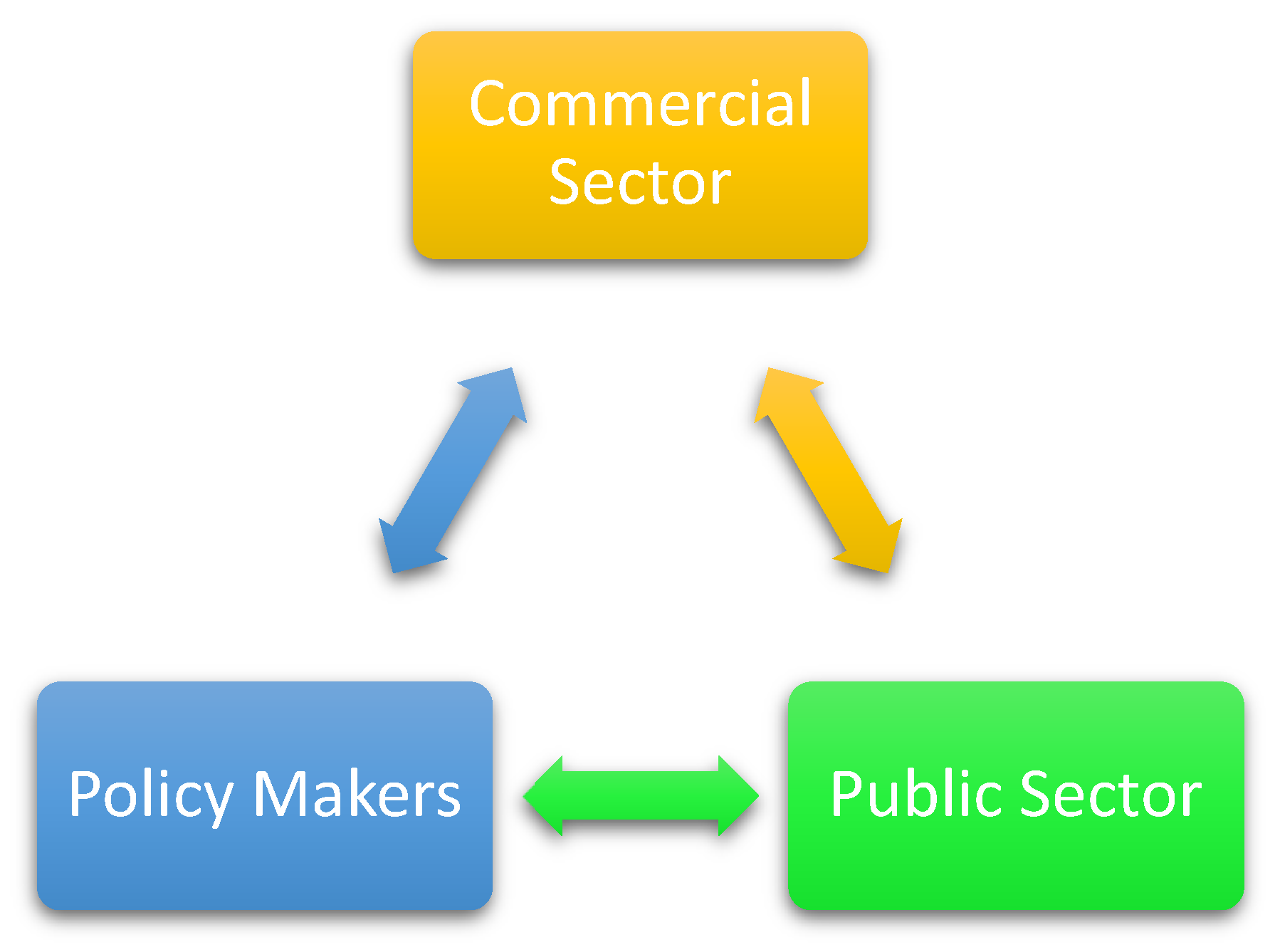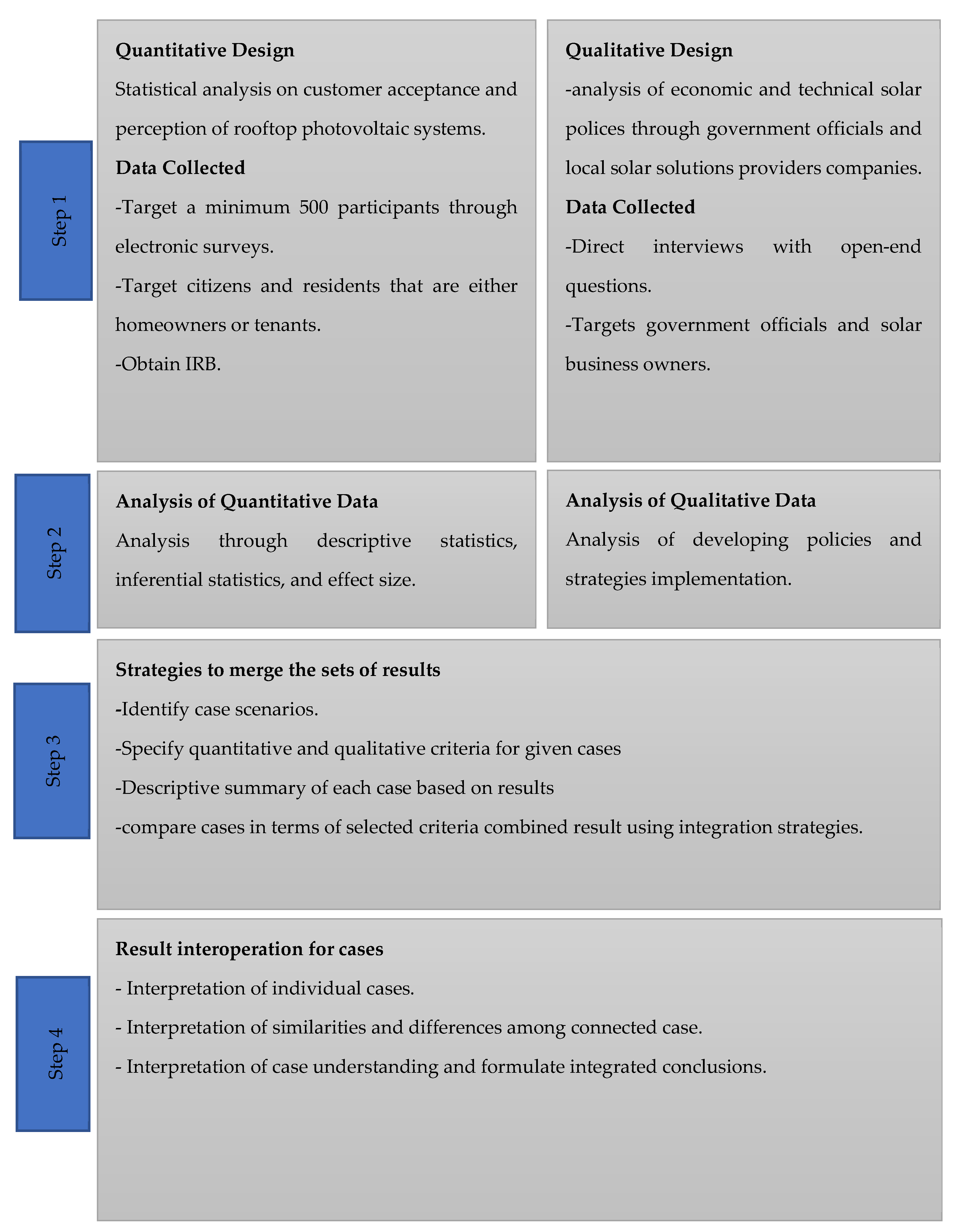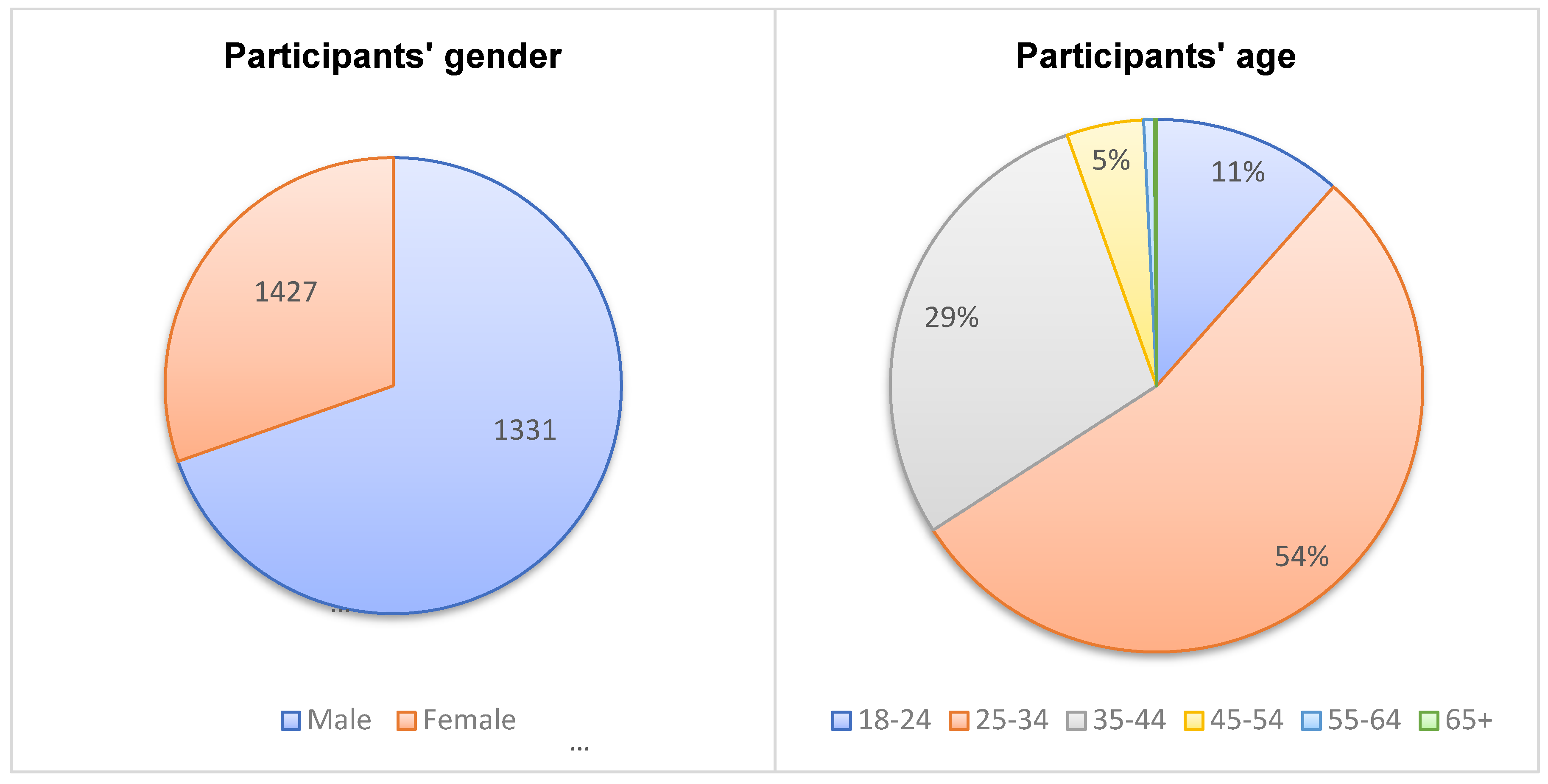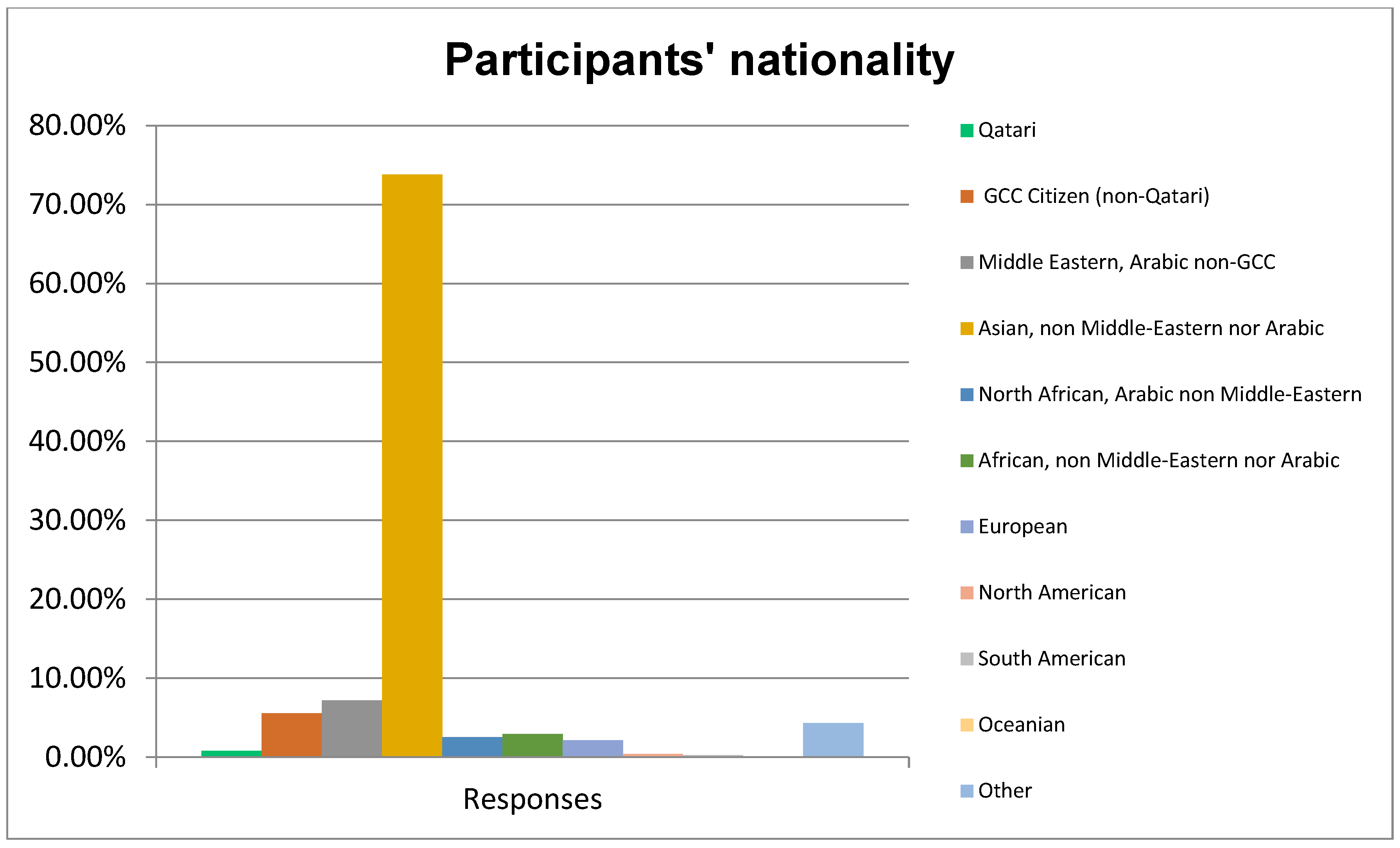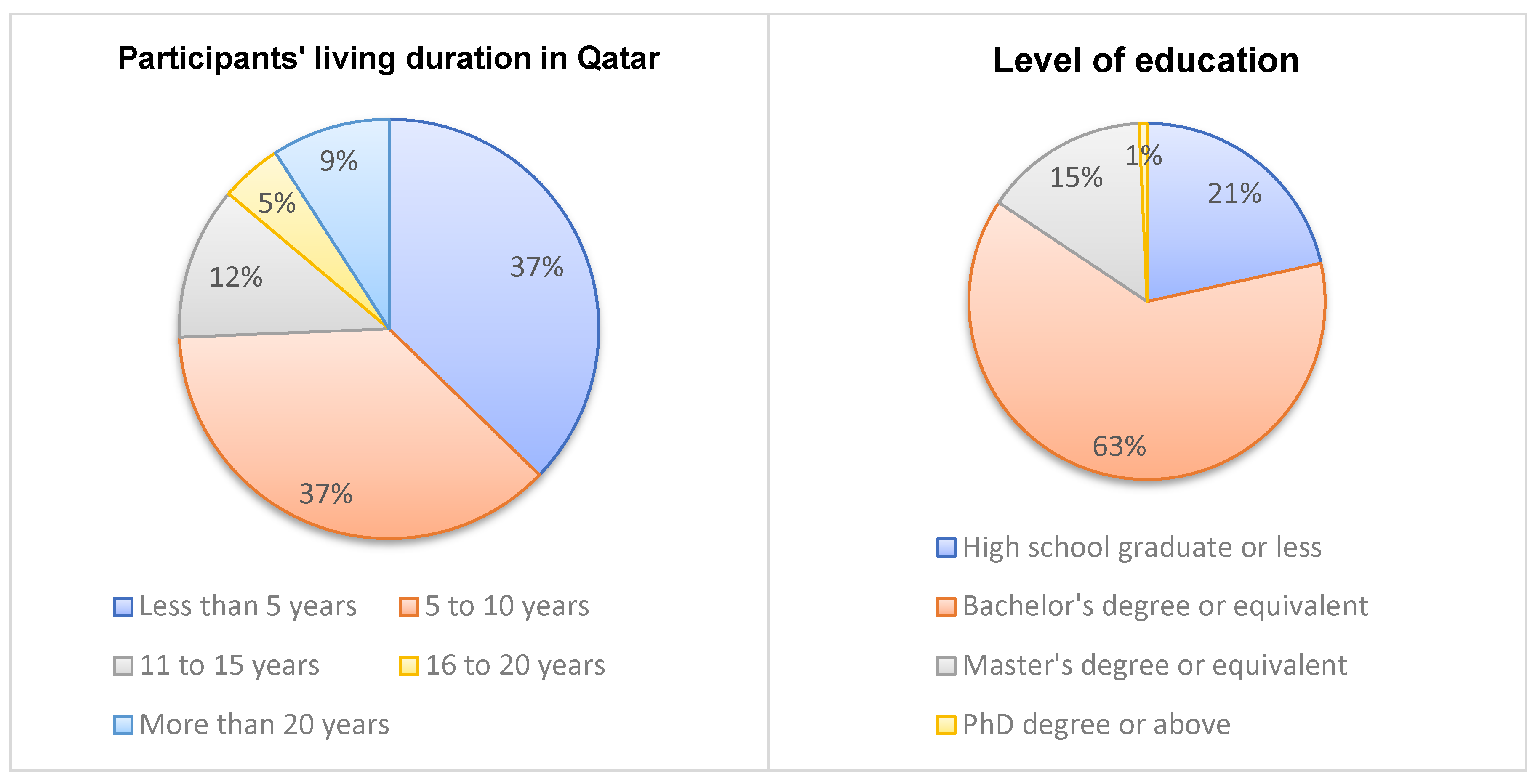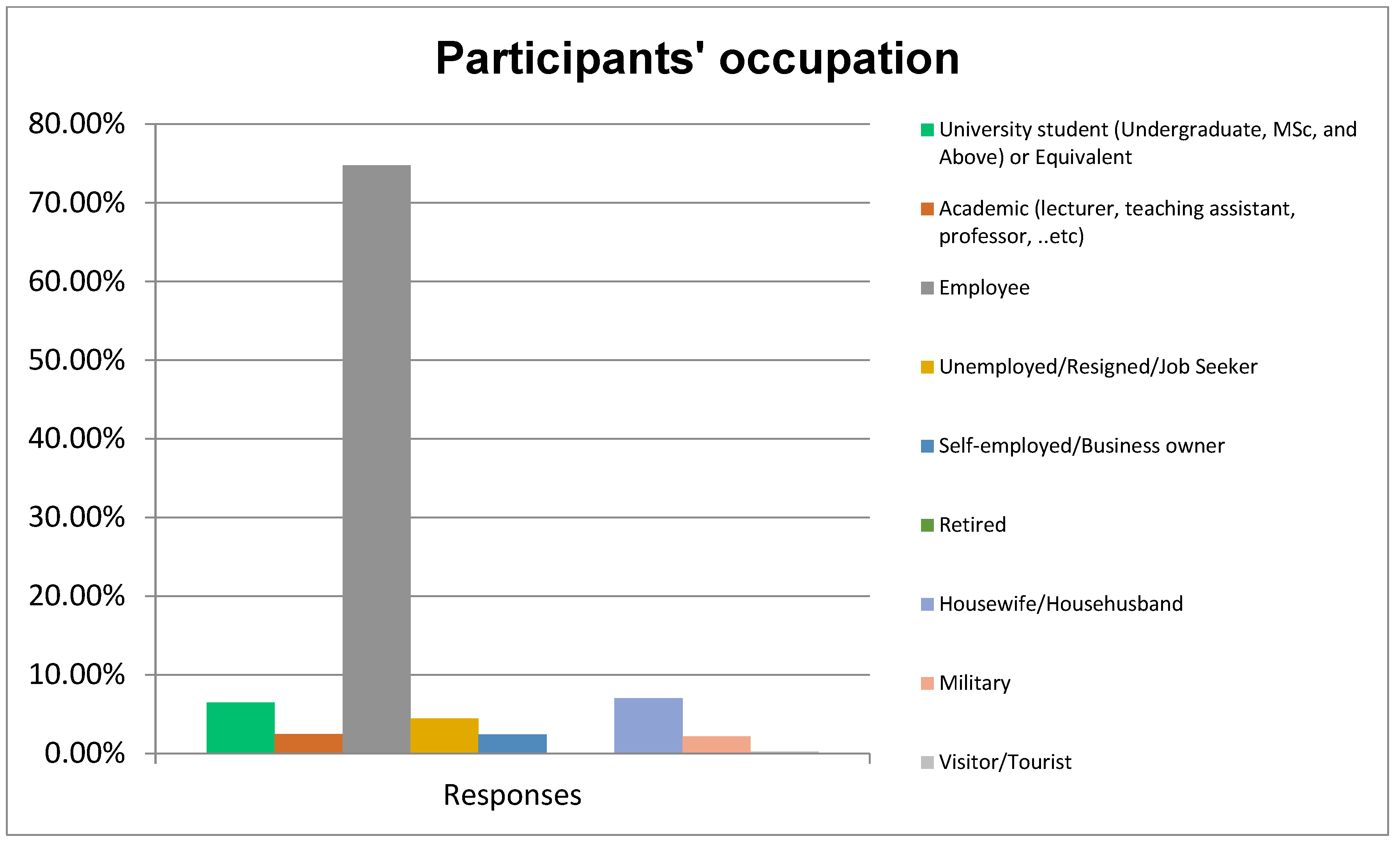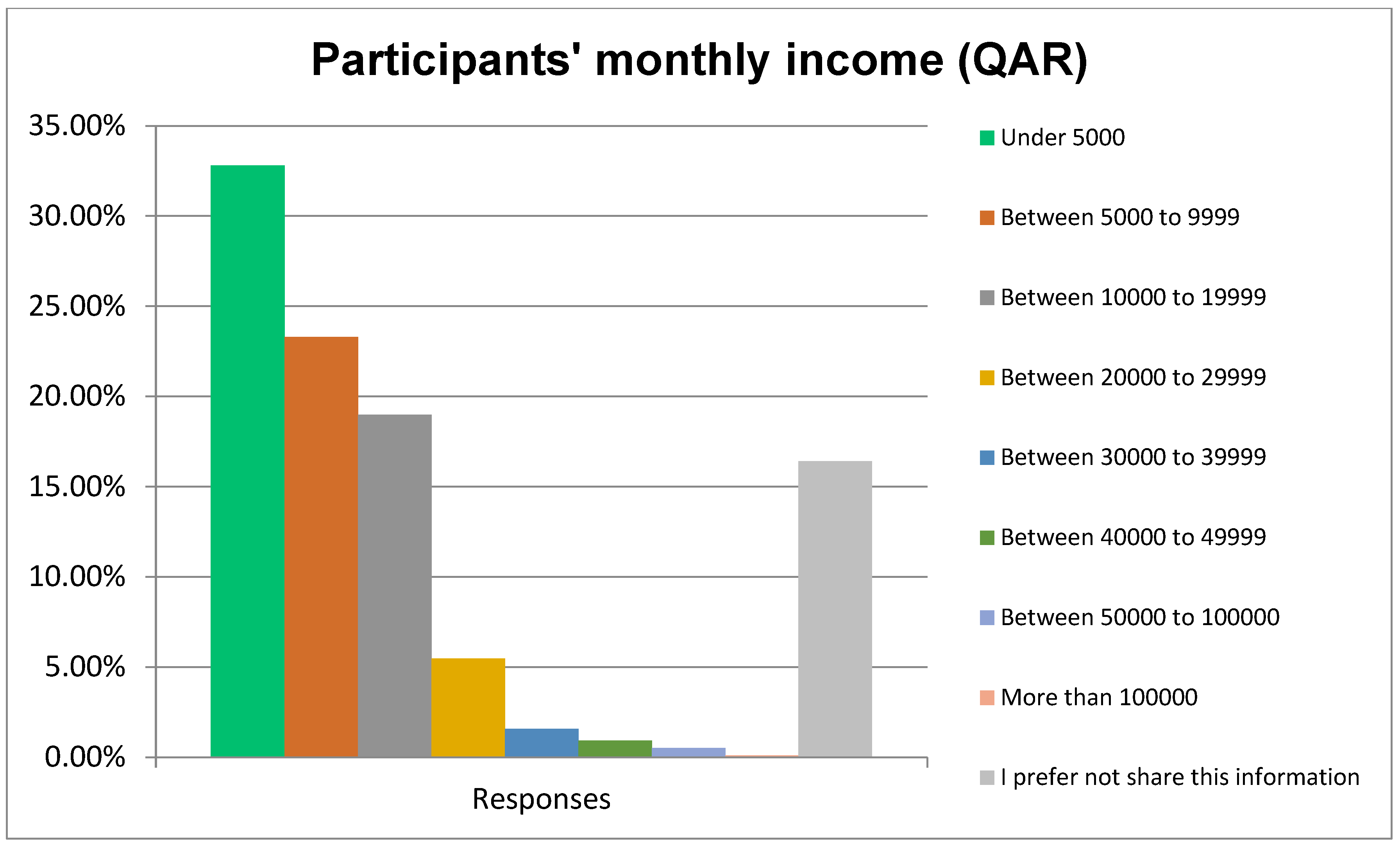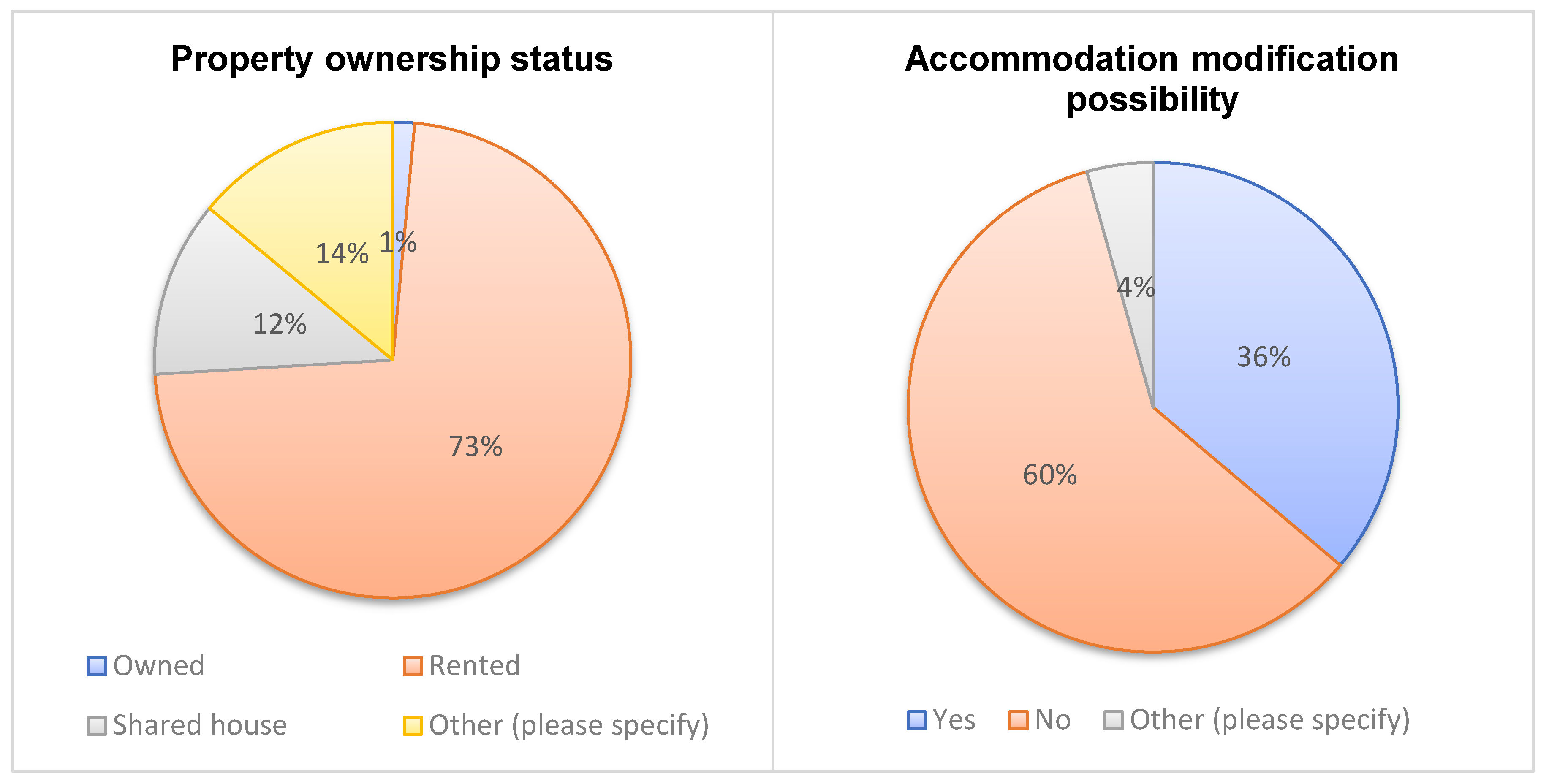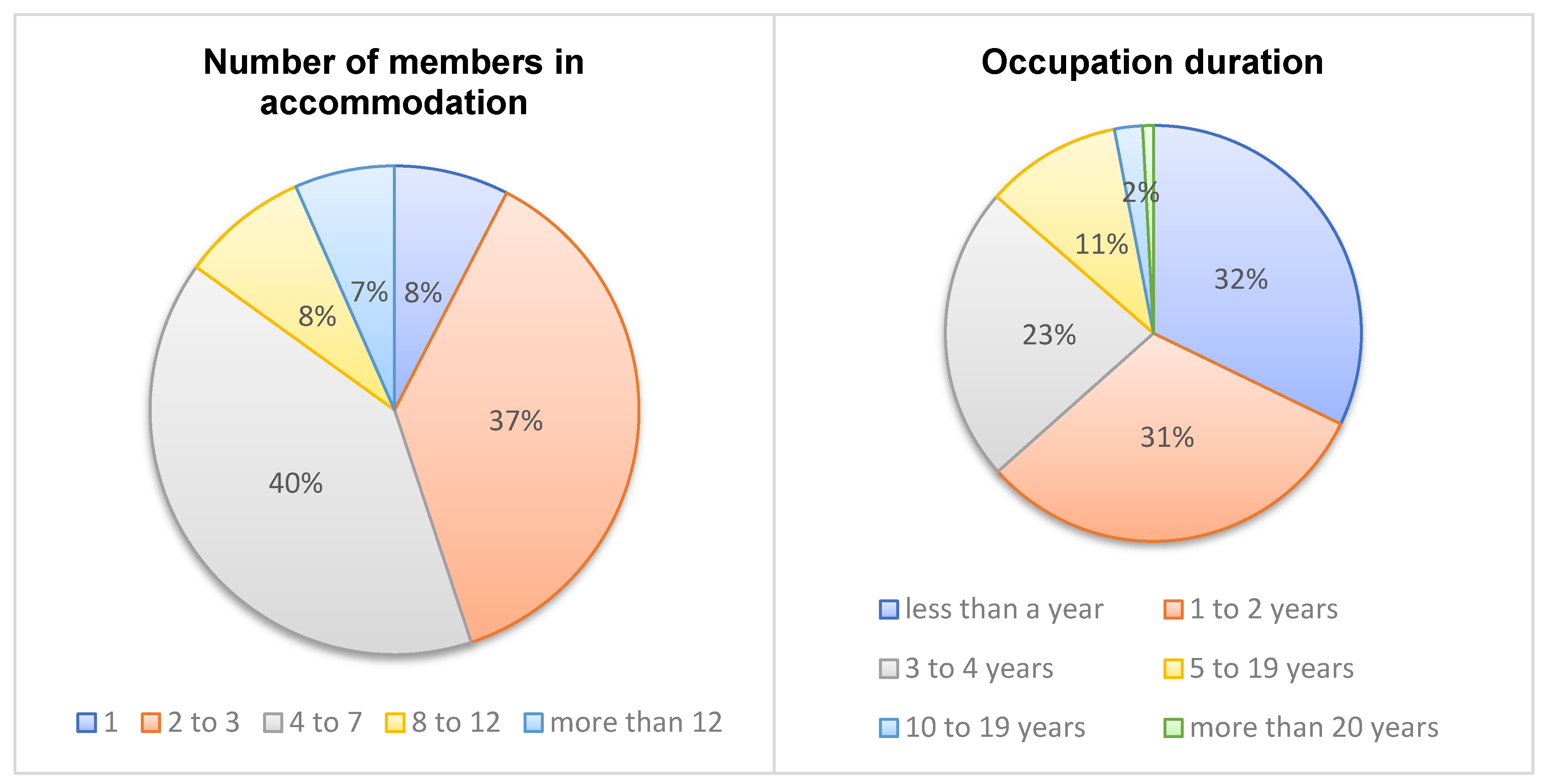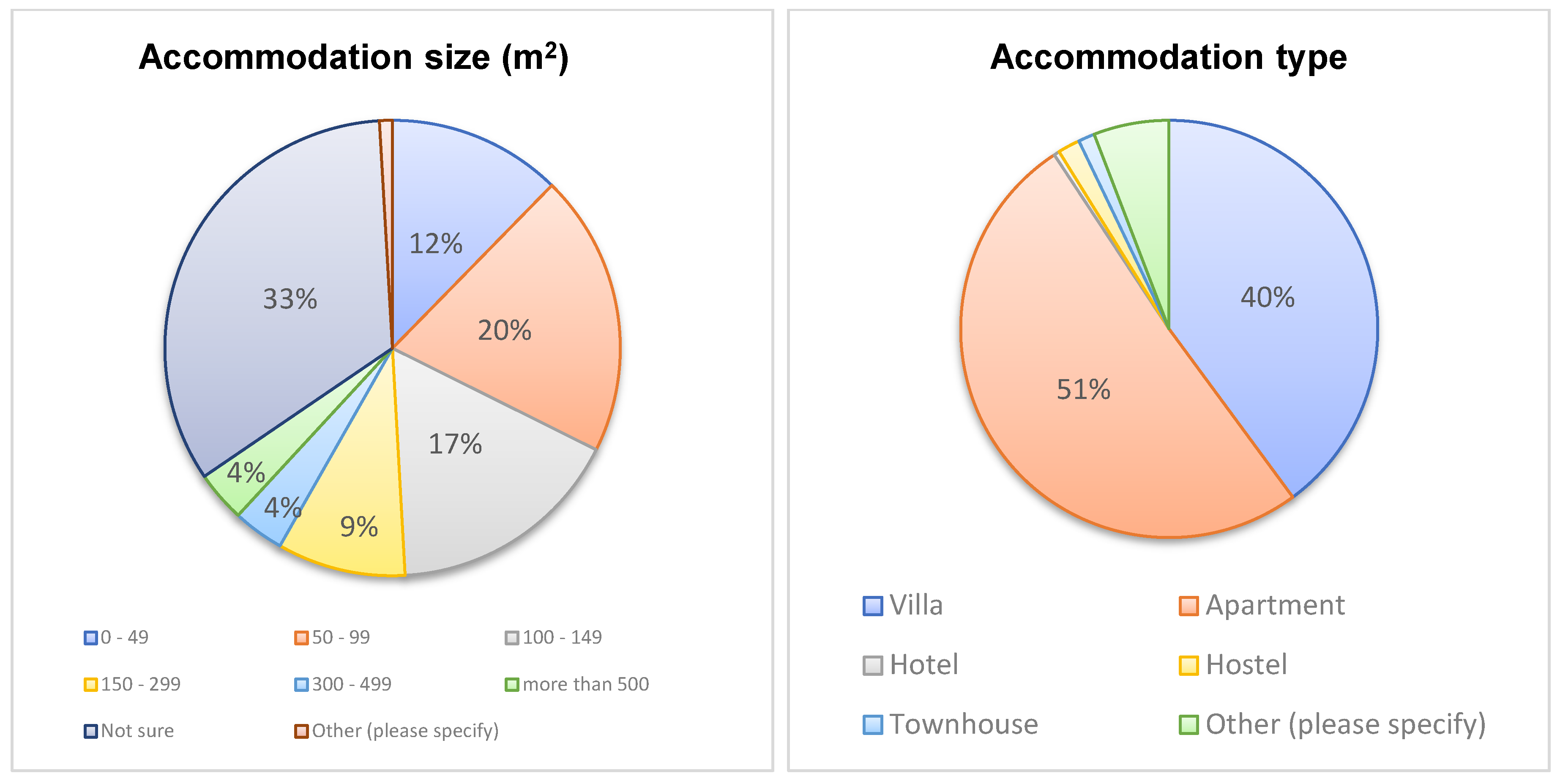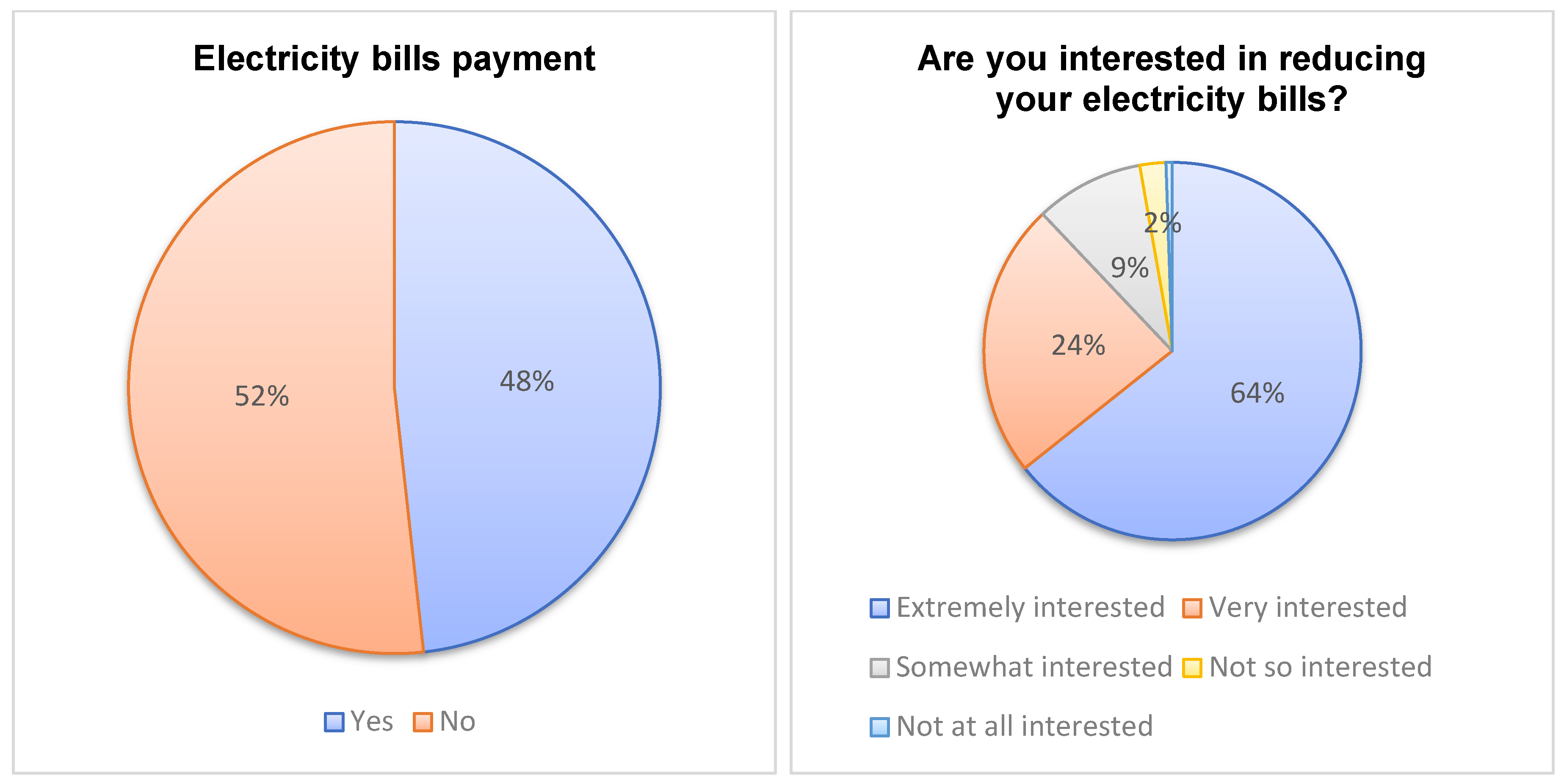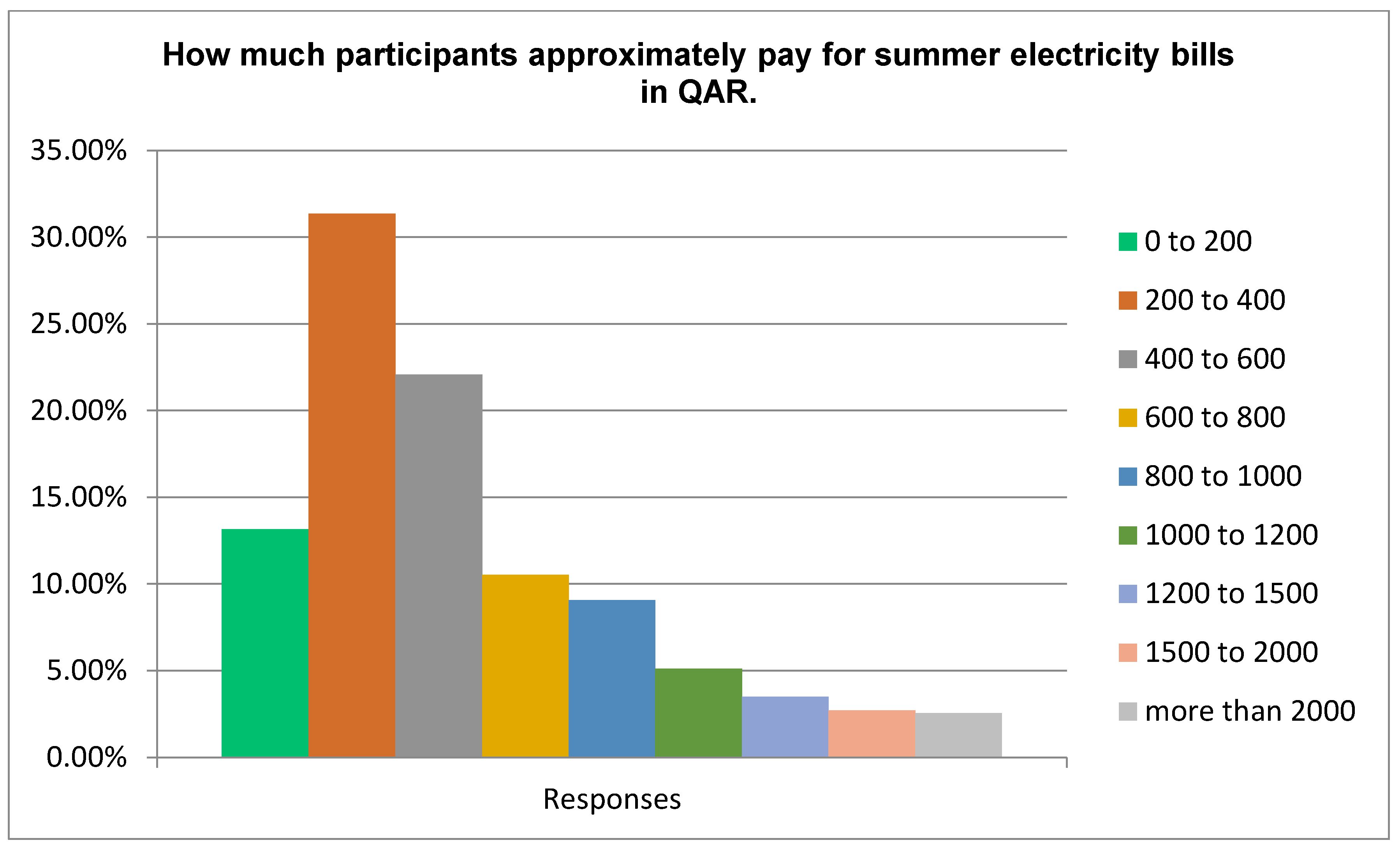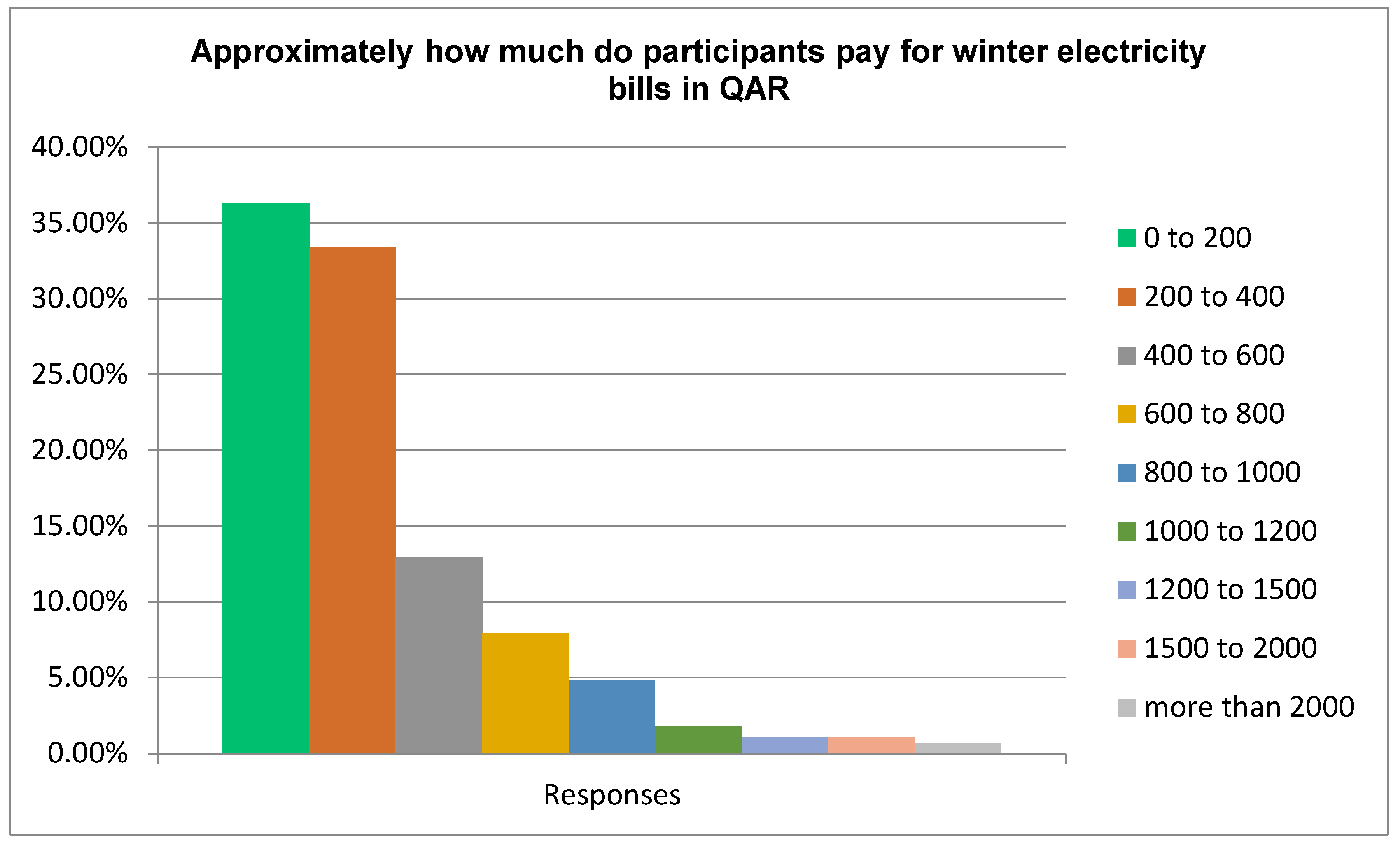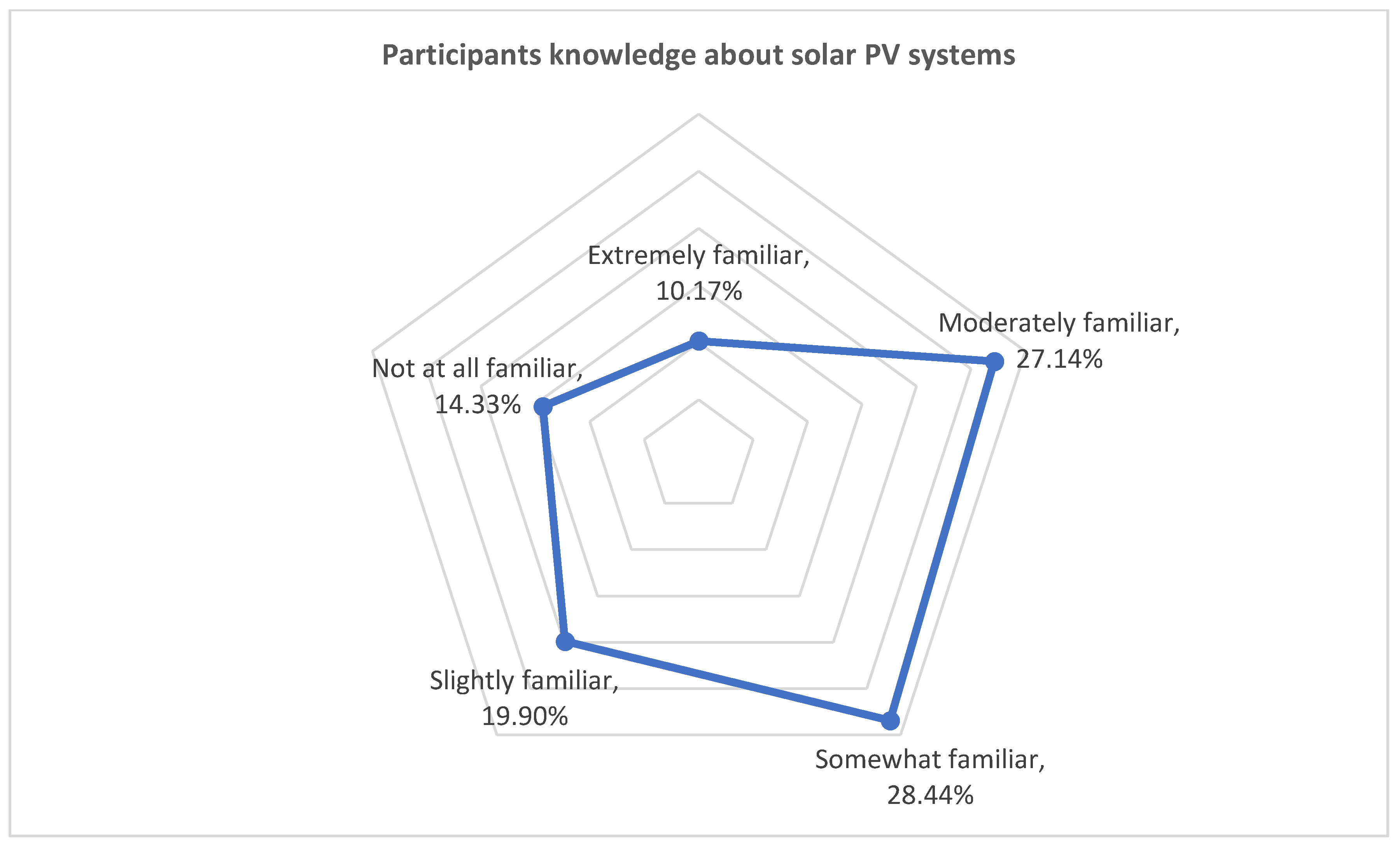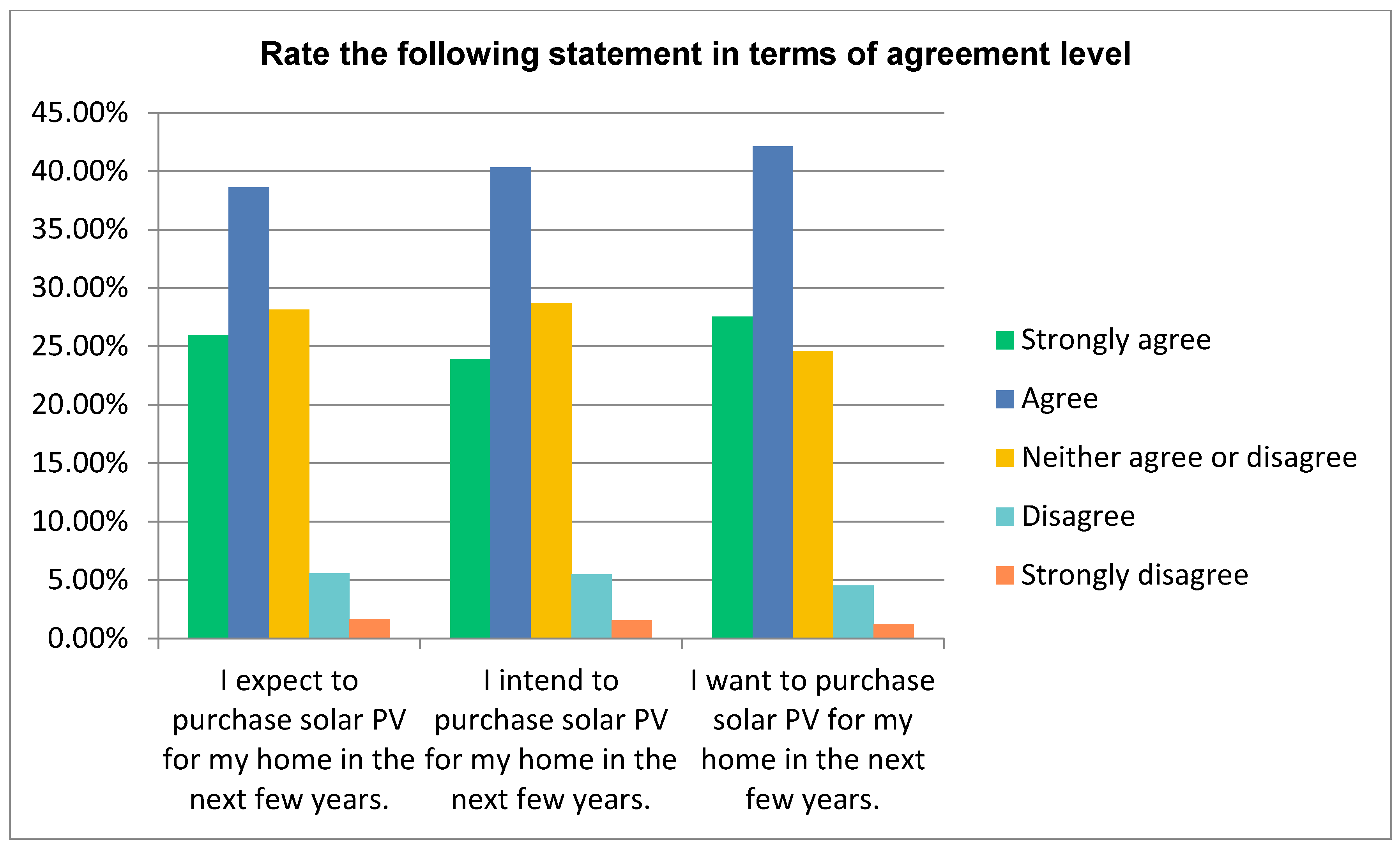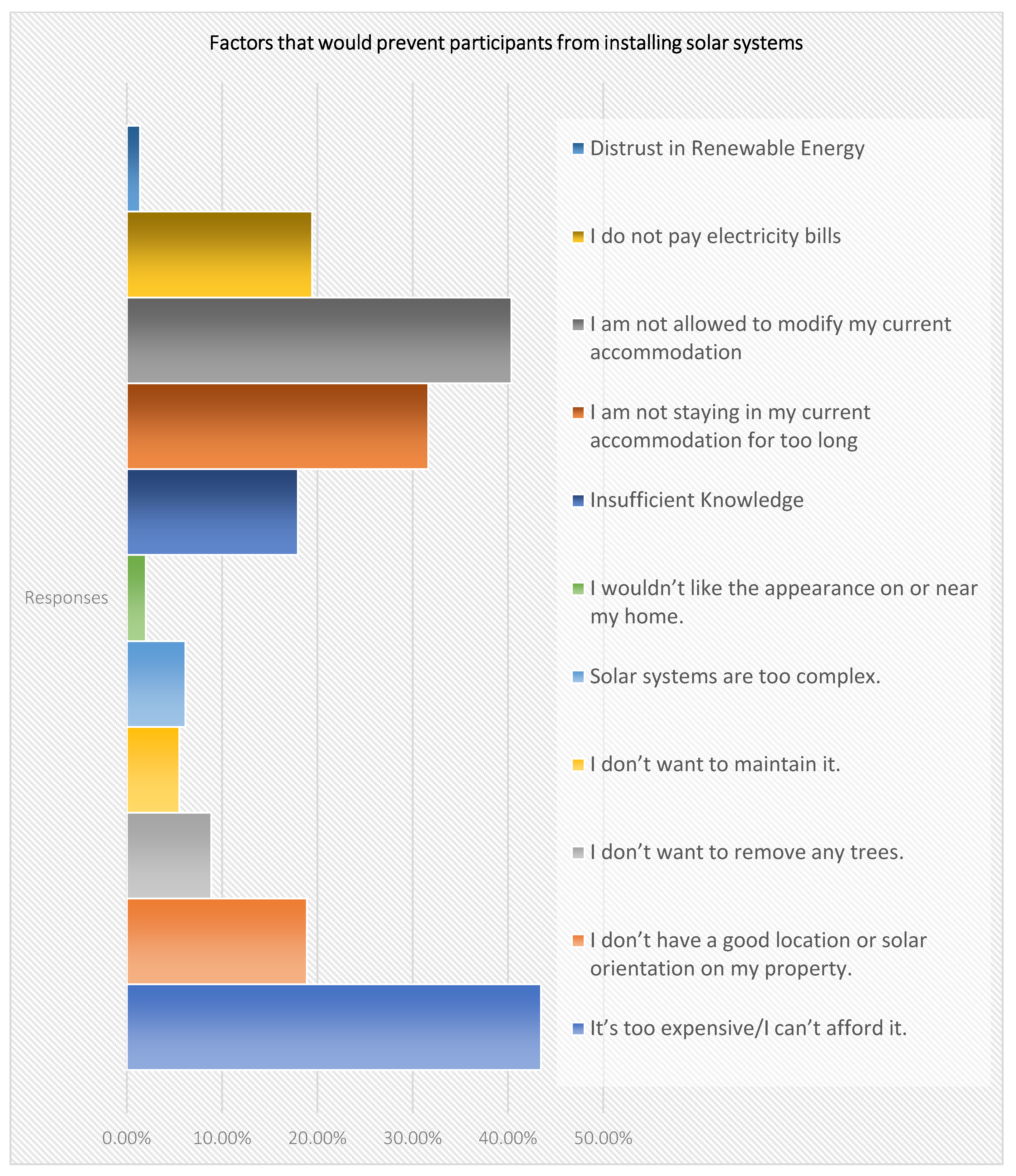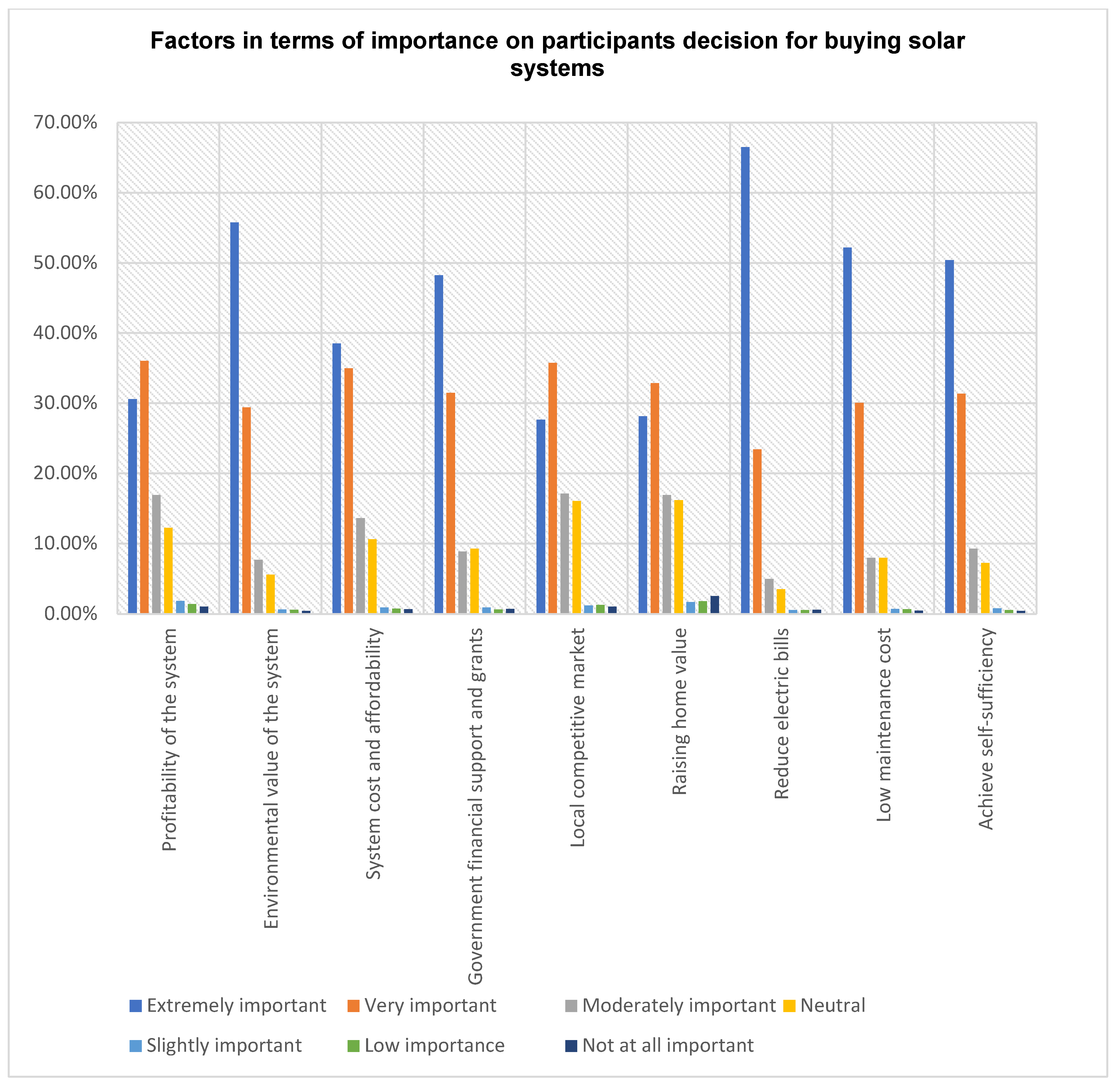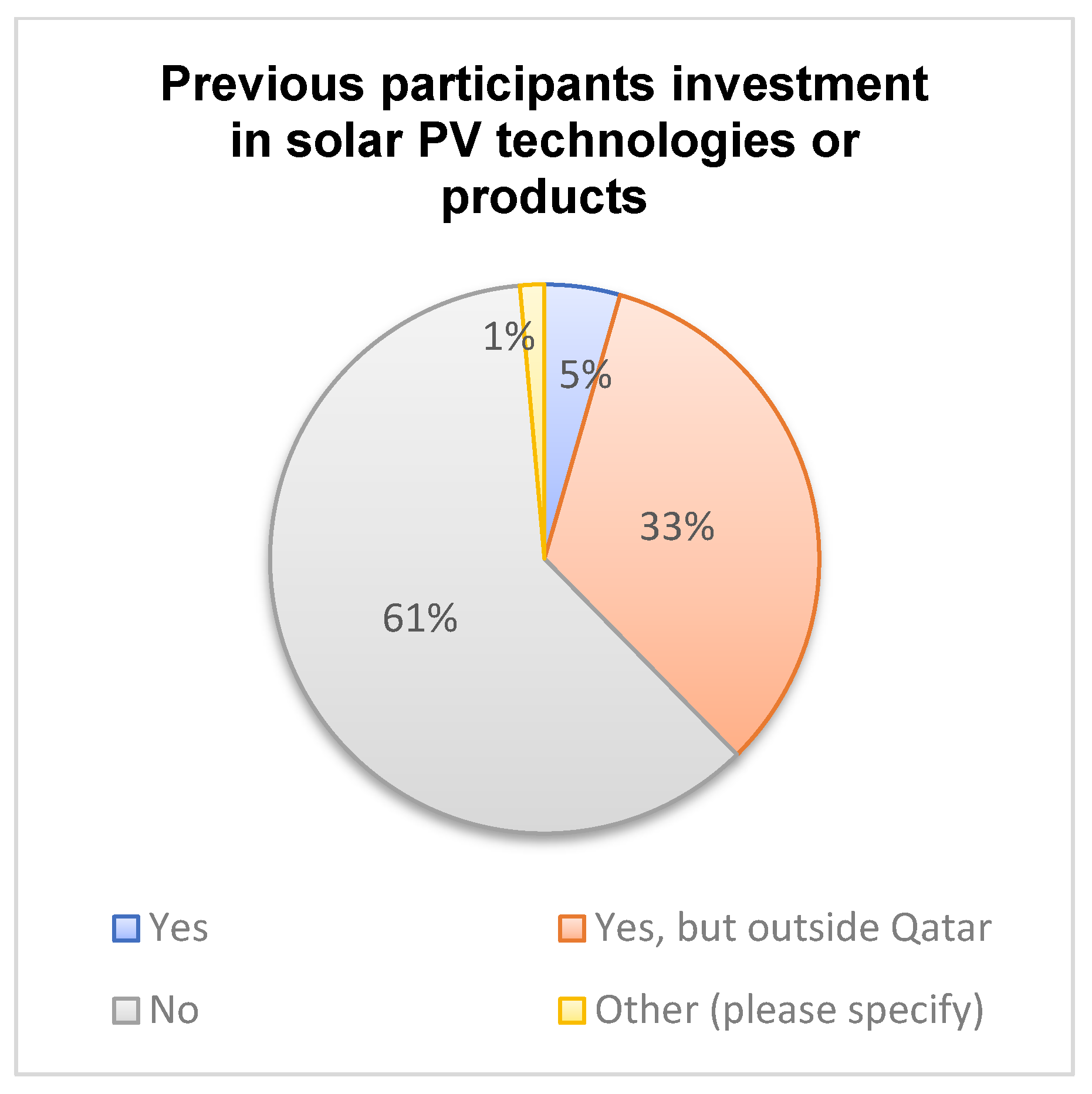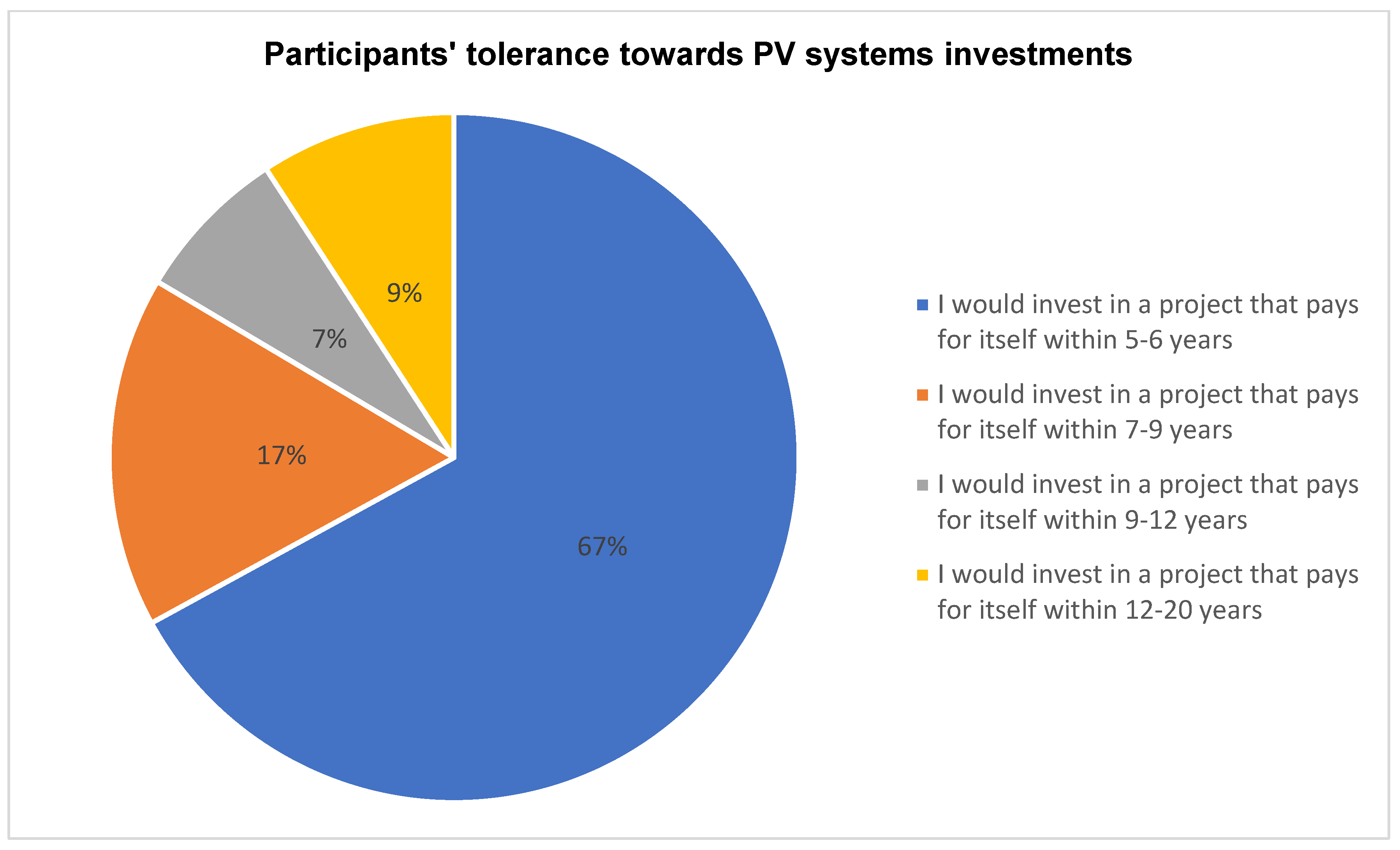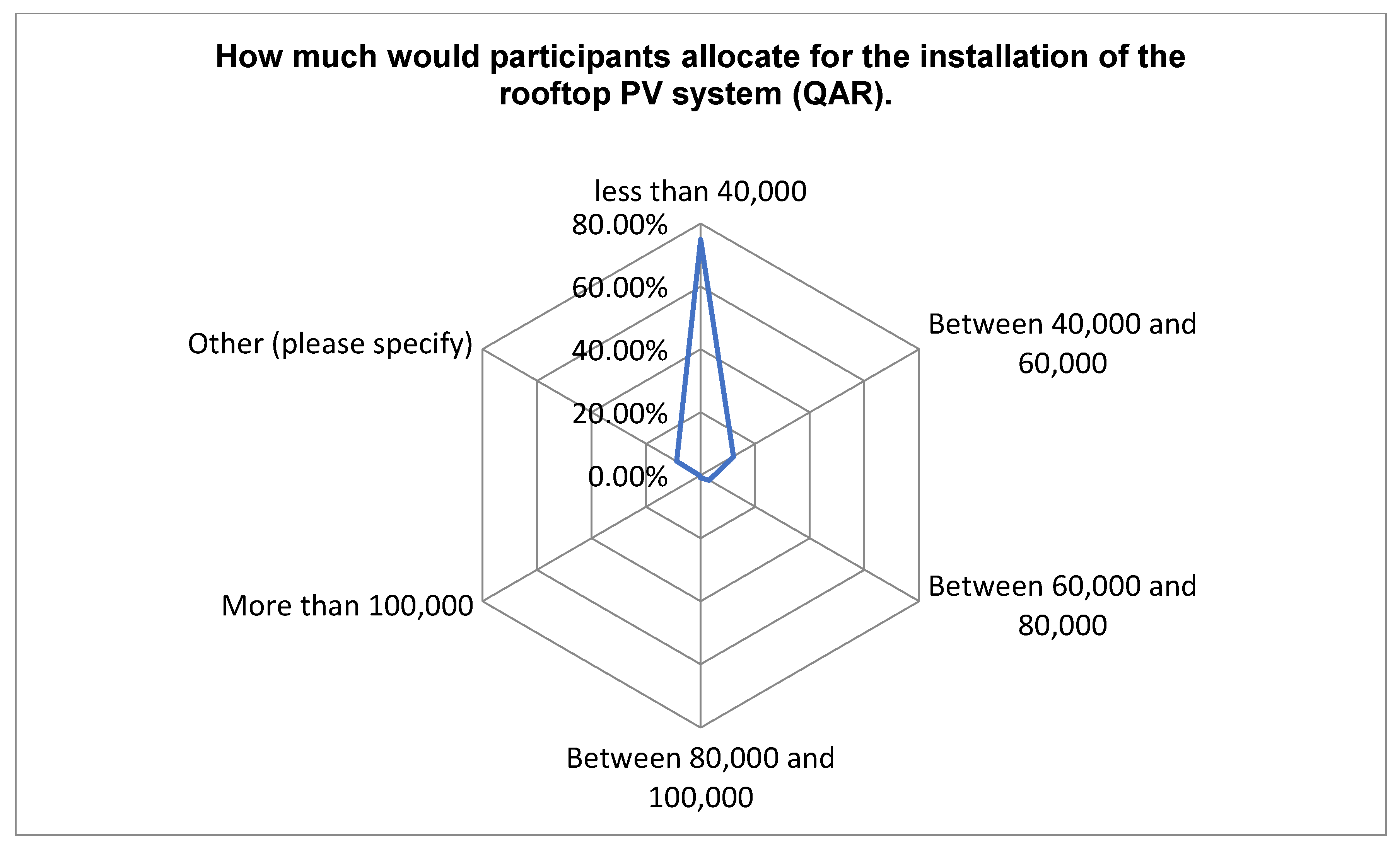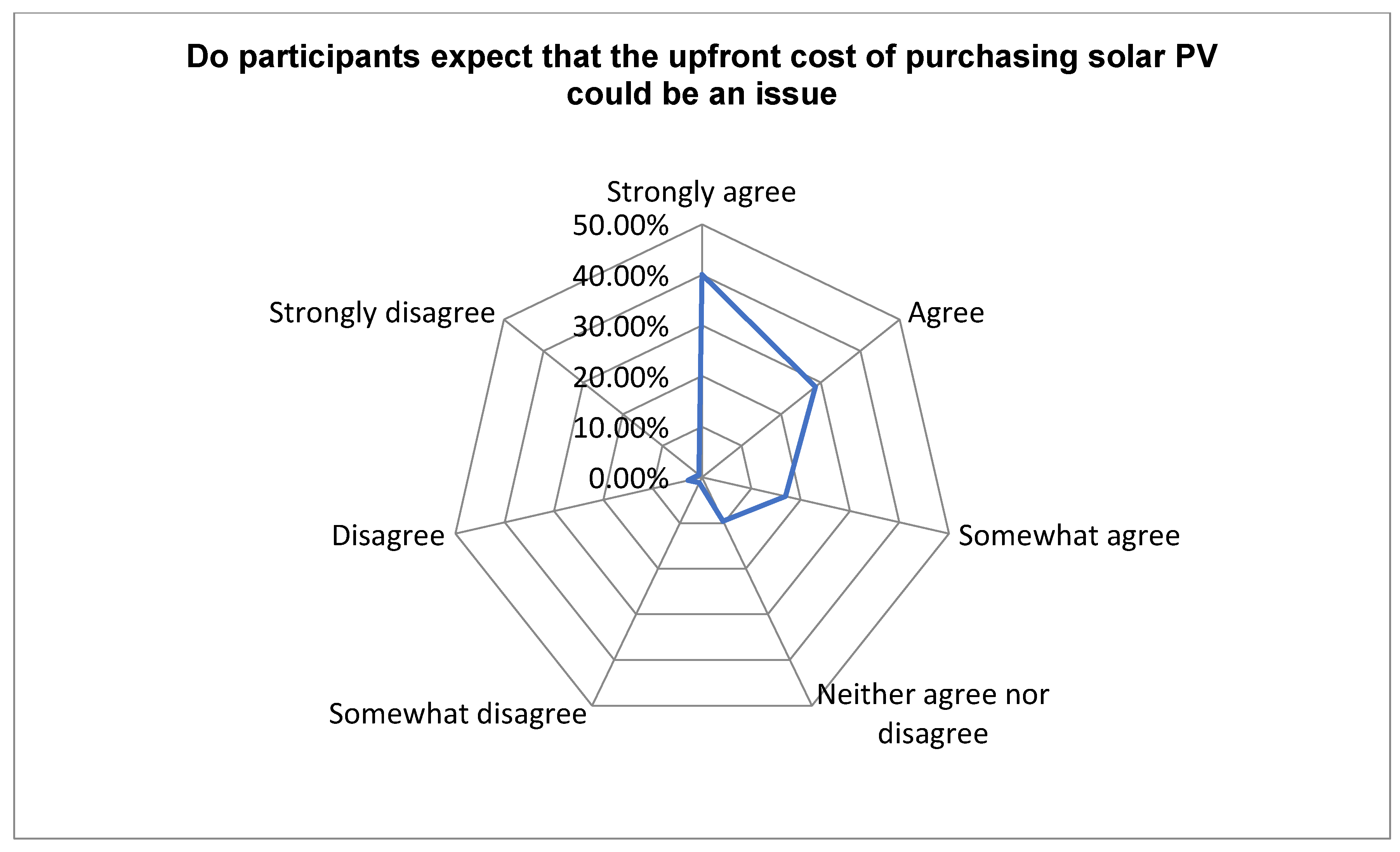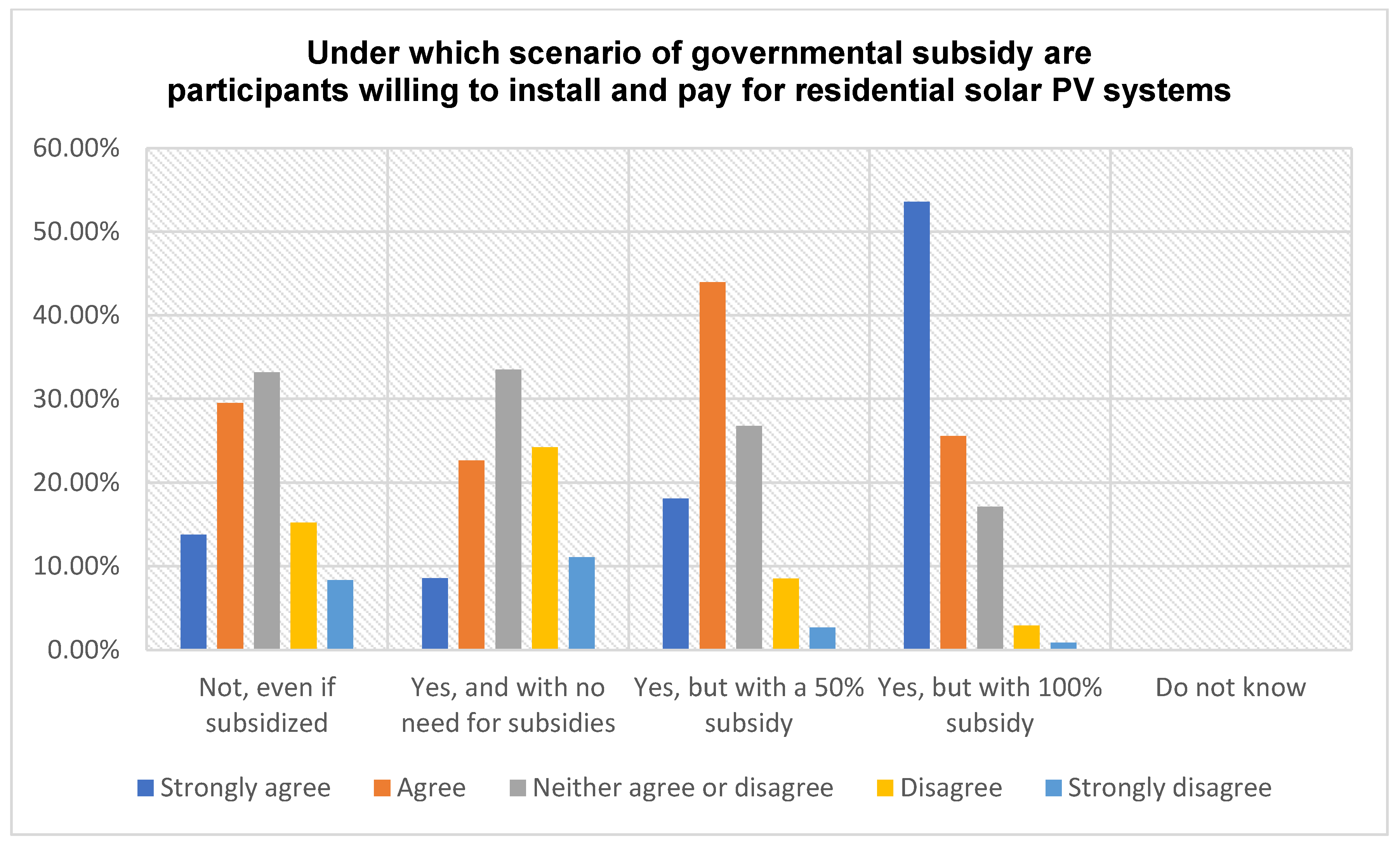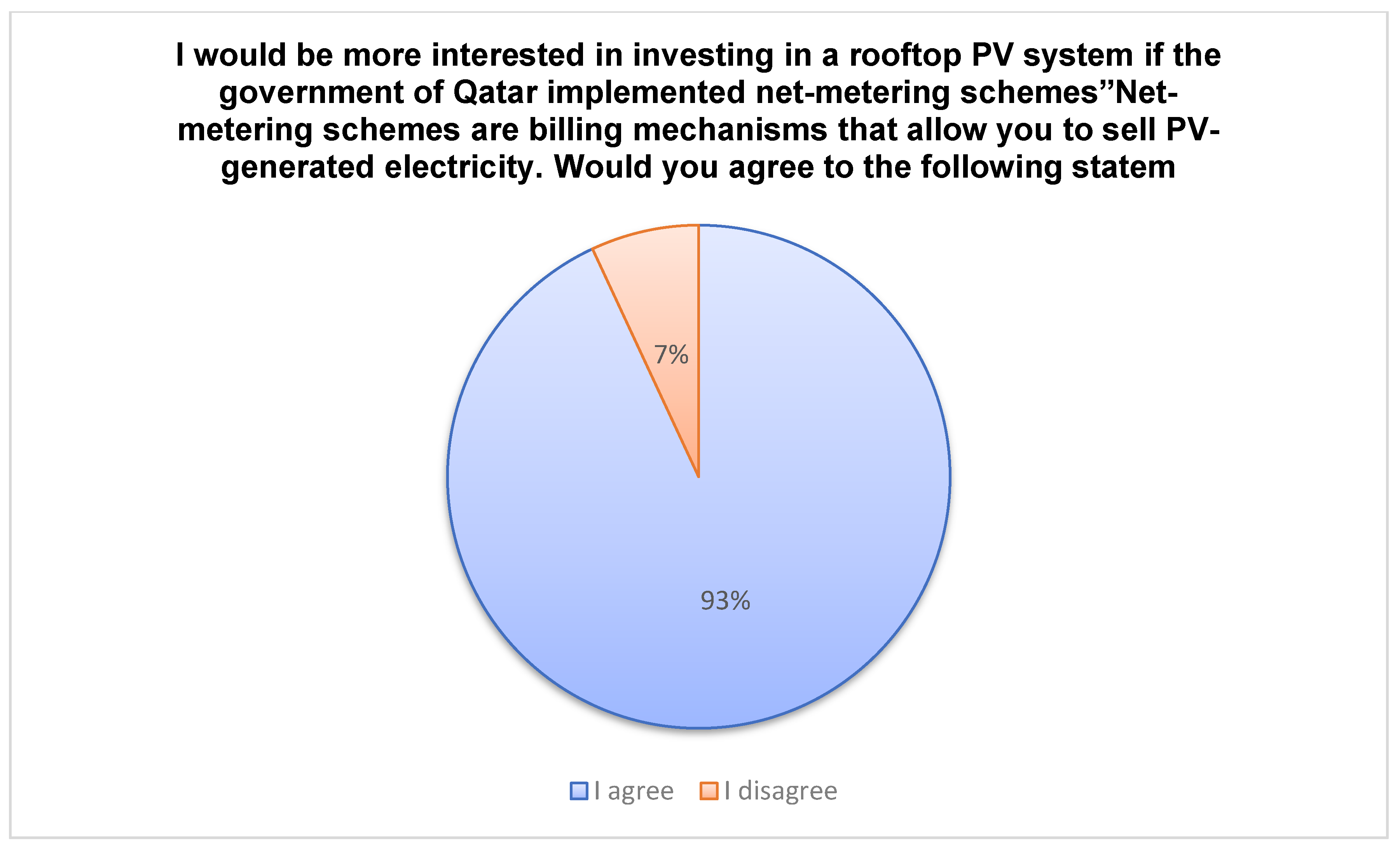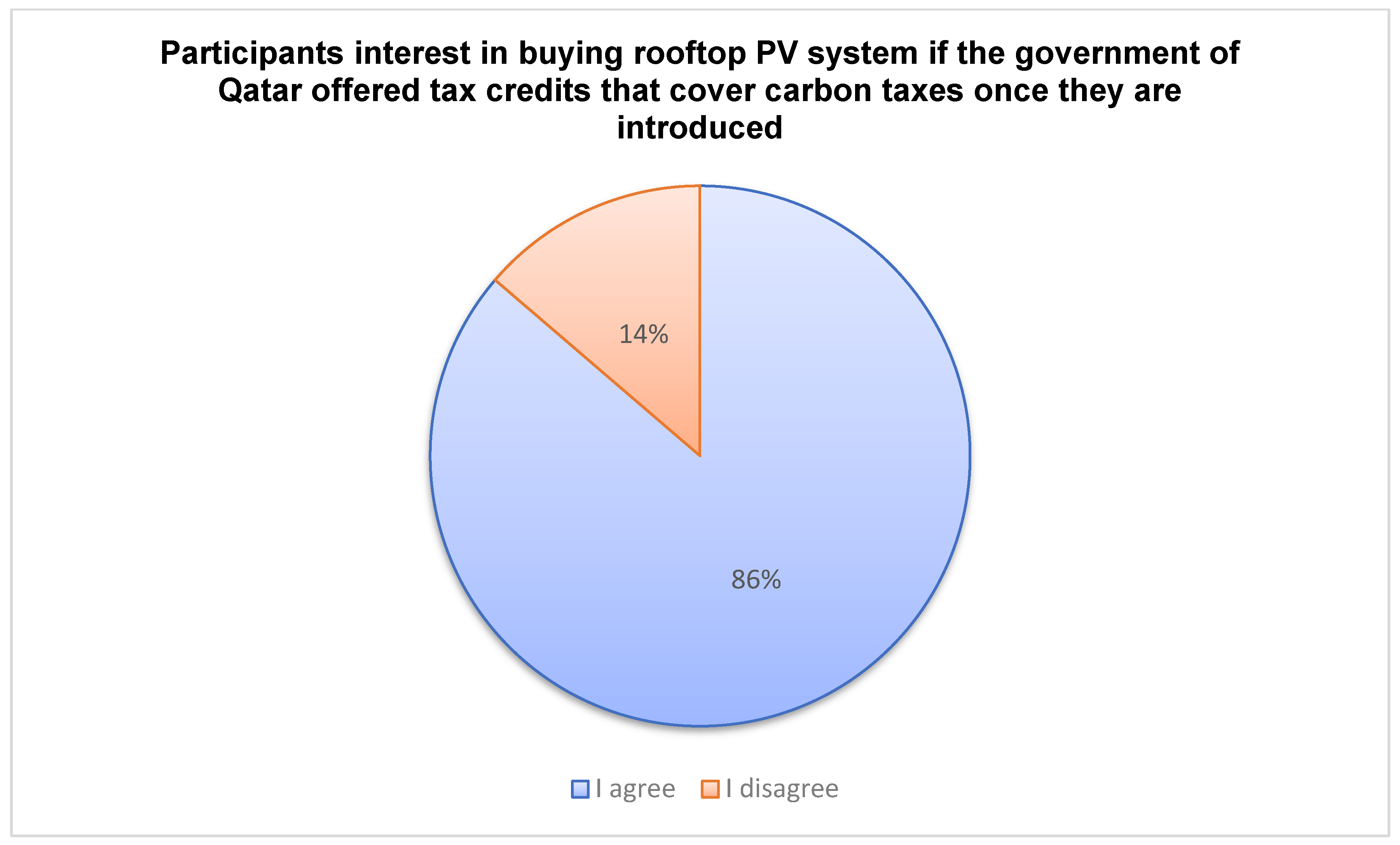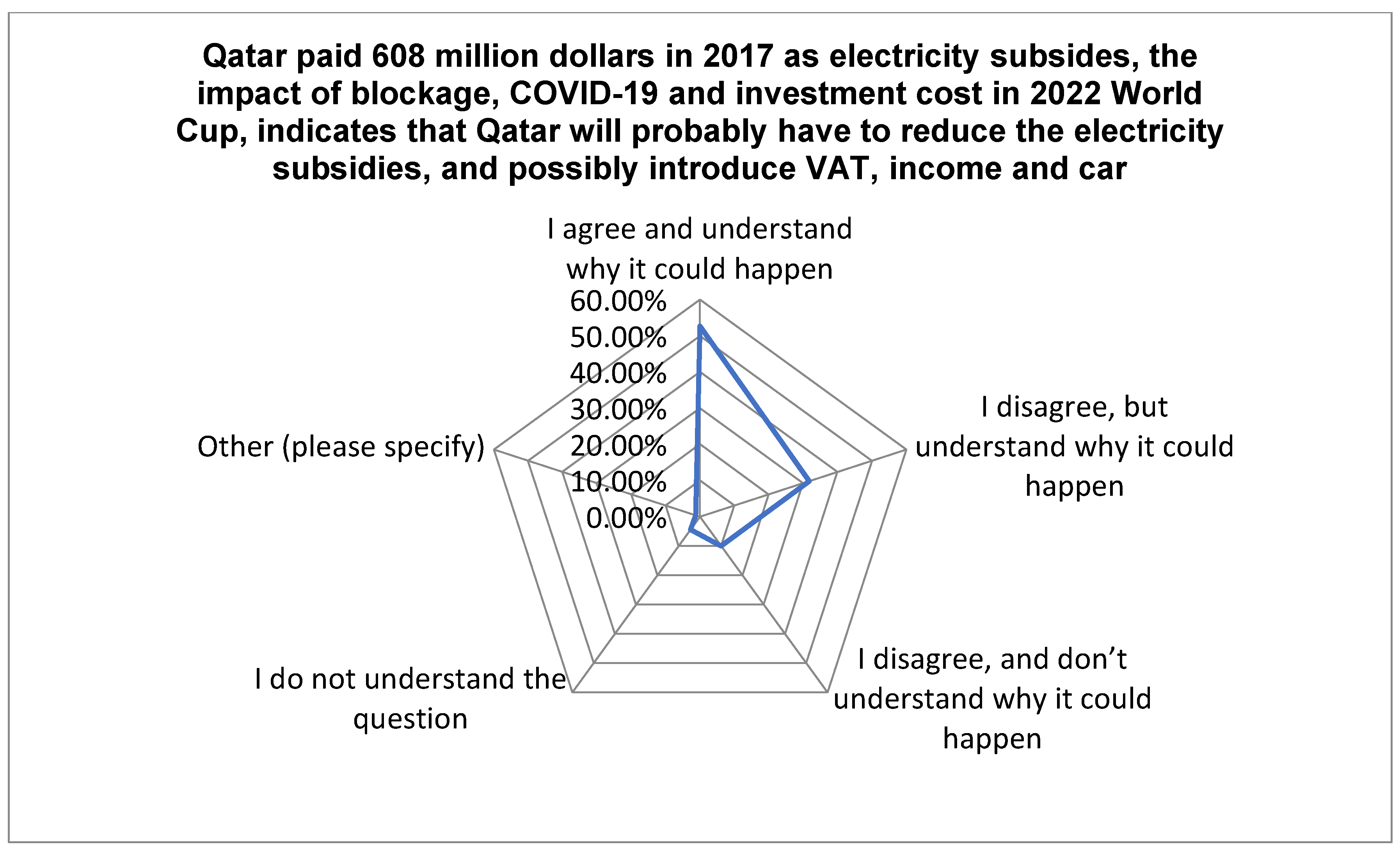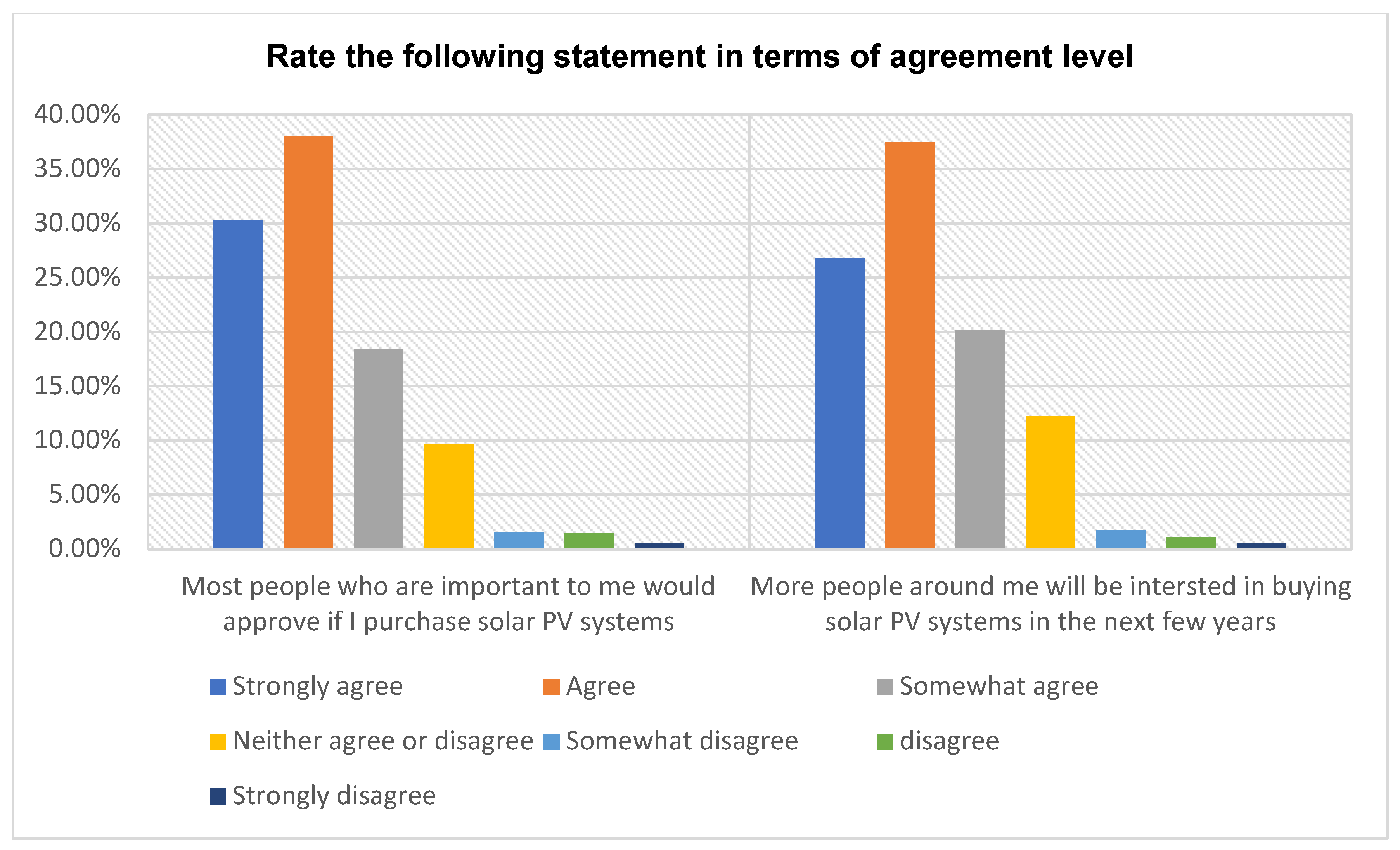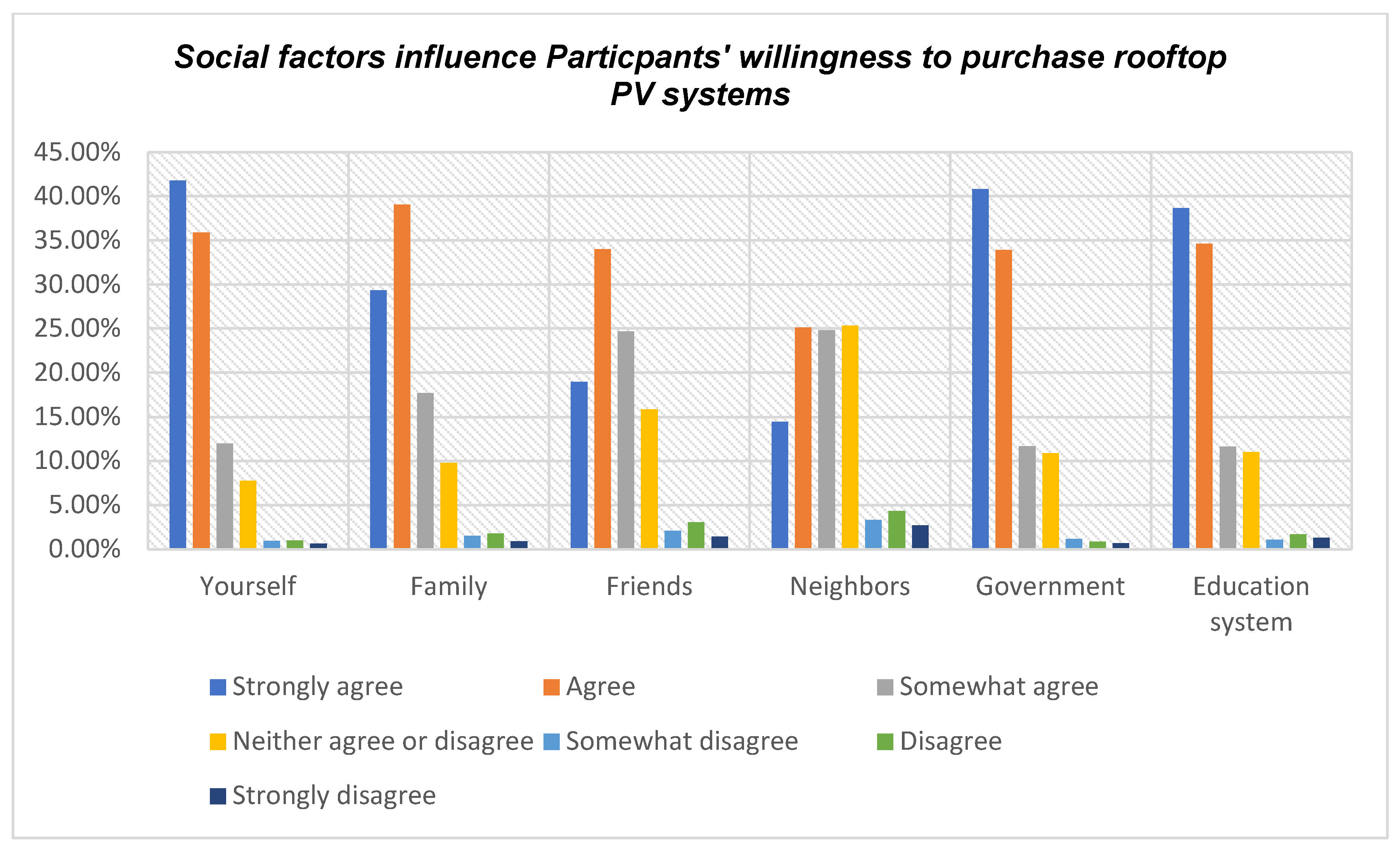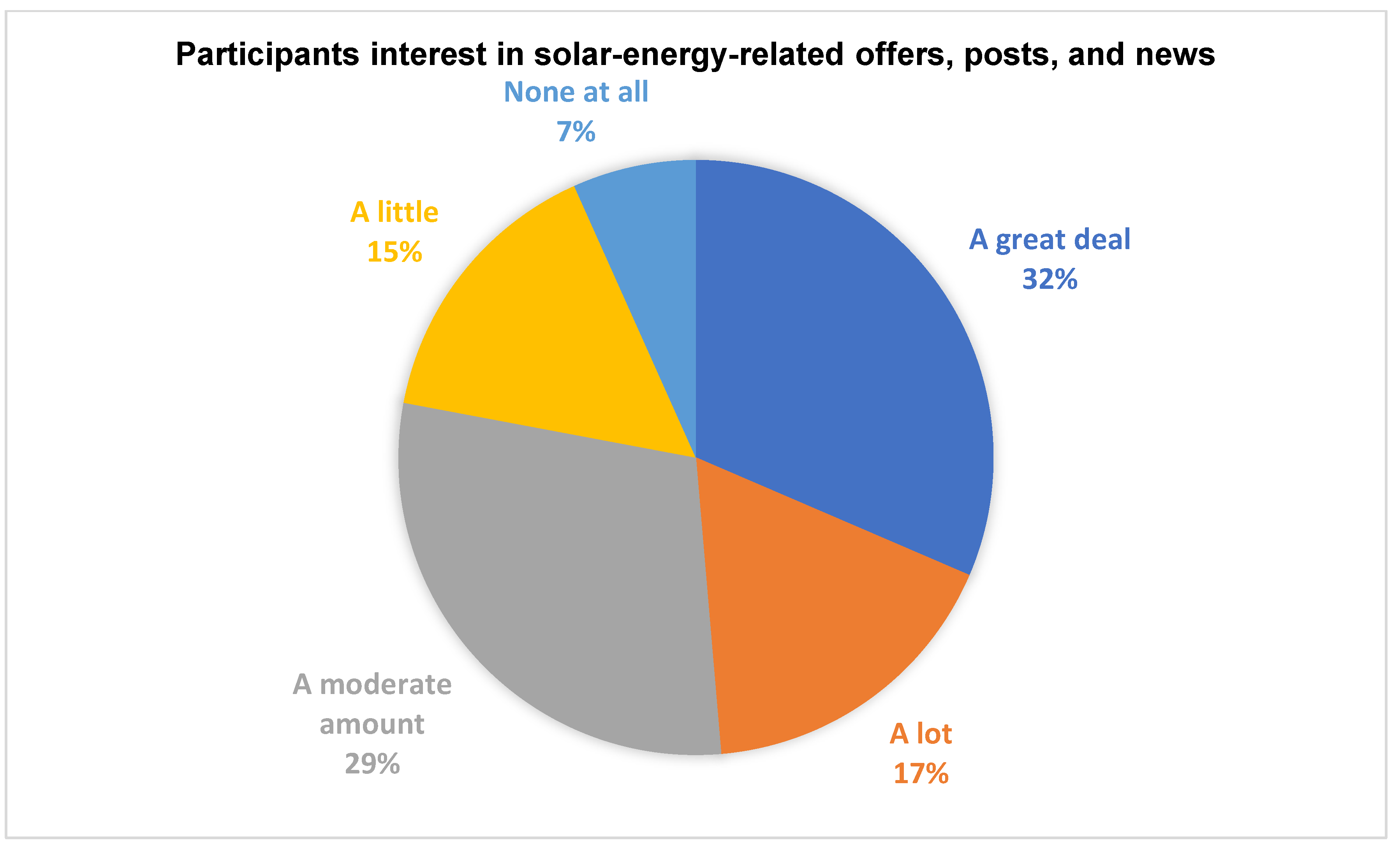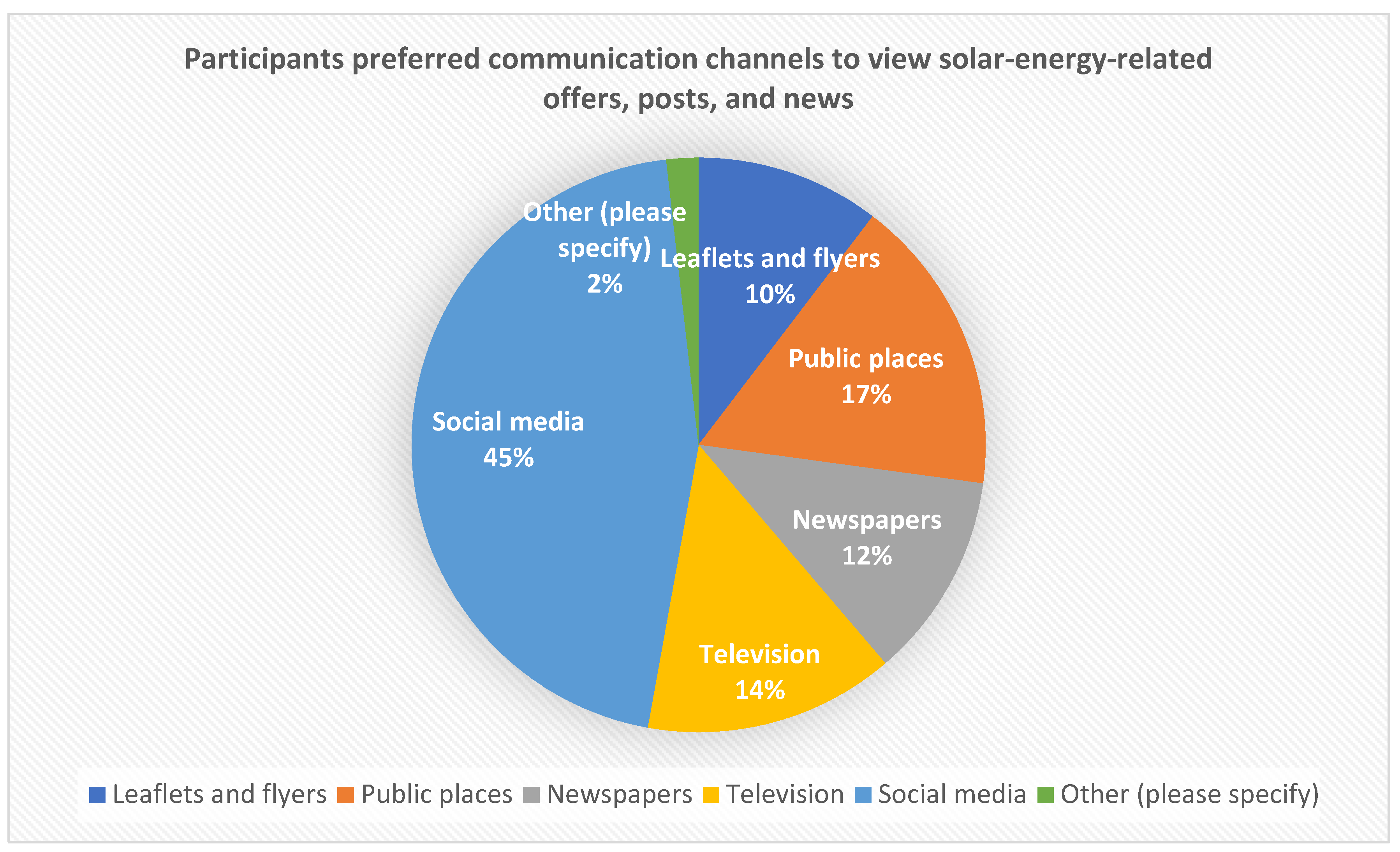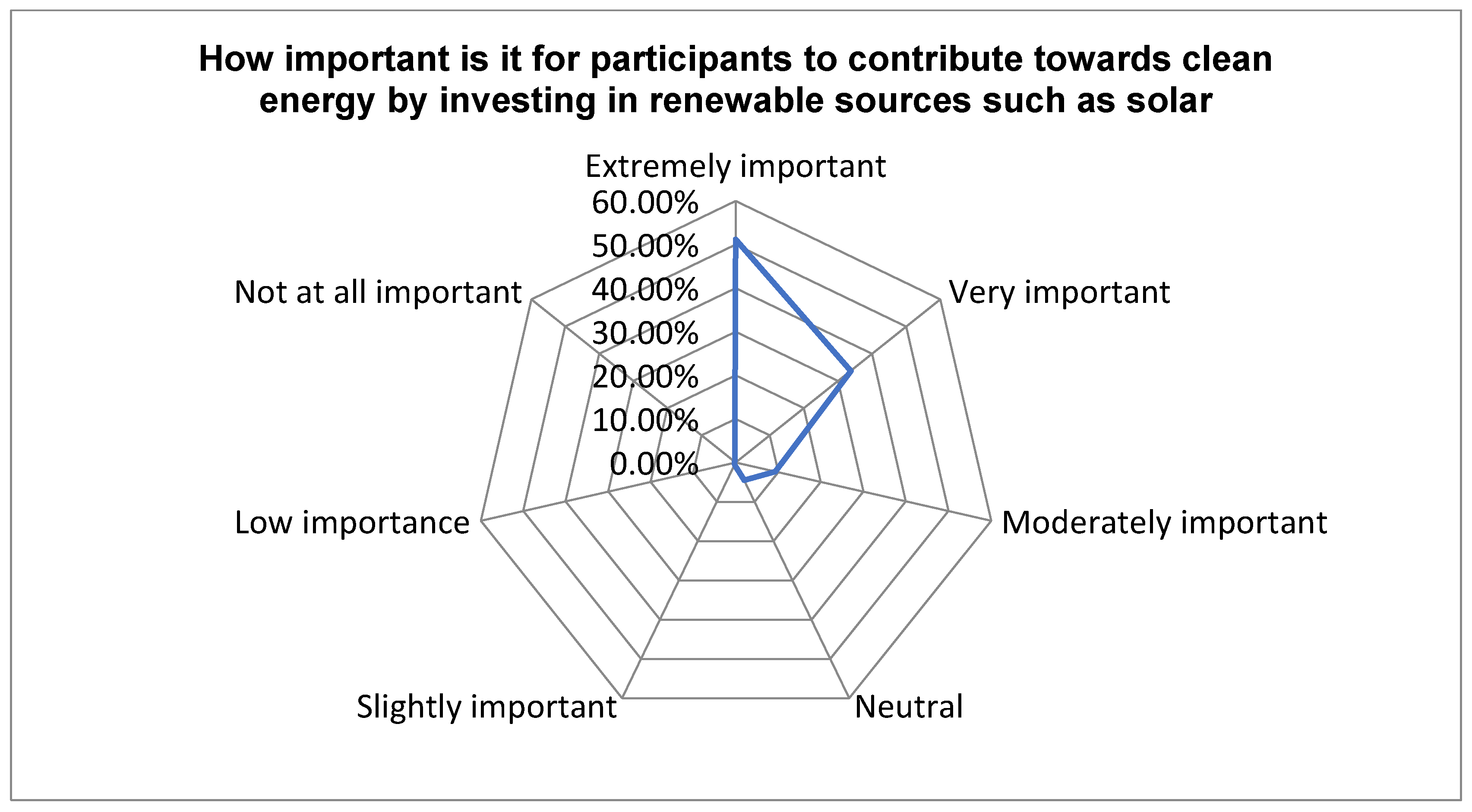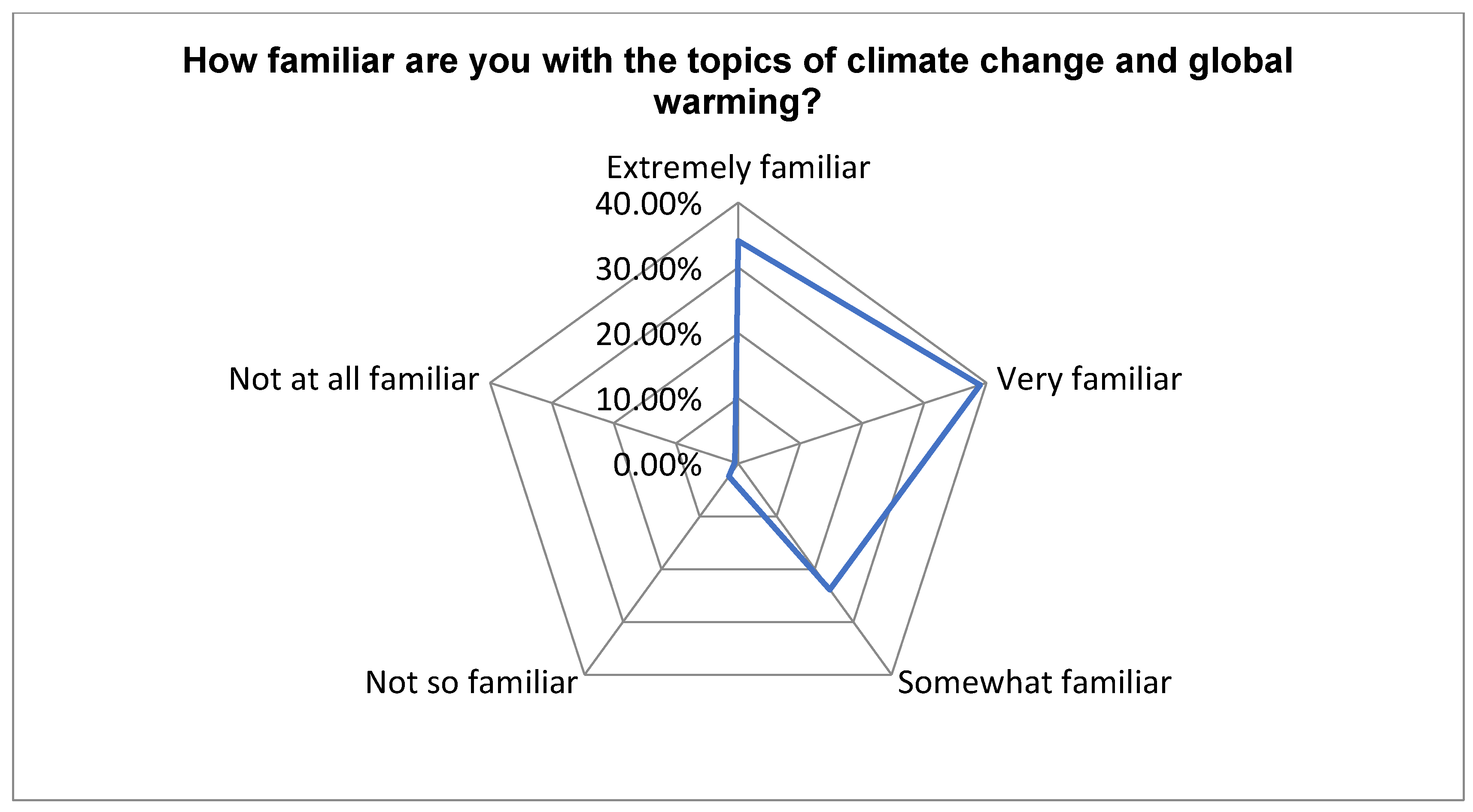1. Introduction
The adoption of renewable energy sources has been influenced by critical global issues, such as global warming and climate degradation. Photovoltaic (PV) systems are a leading sustainable and renewable energy option, especially for large-scale deployment on residential rooftops. However, the adoption of residential rooftop PV systems is dependent on various barriers, including public perception and acceptance, market readiness, and supportive government policies. While most studies have focused on customer perception or market penetration, this study takes a combined approach. According to previous research, there are three types of motivators: social (peer influence) [
1], economic (solar cost) [
2,
3], and environmental (reduced pollution) [
4,
5]. Adding to that, past work also found that the timing of economic events in one’s life can influence a homeowner’s readiness for adoption (e.g., acquiring inheritance may enable the purchase of solar equipment). This literature on the motivations for adopting residential solar technology suggests several important economic considerations, such as upfront cost, economic savings, economic incentivization, environmental values, peer influence and access to information, and timing of life events. Furthermore, fieldwork based on the authors’ experiences suggests that attitudes toward solar installers may shape adoption motivations. In exploring elements that drive PV adoption, including environmental motivations, economic considerations, and demographic characteristics, past work finds that adoption can be influenced by the timing of economic events in a homeowner’s life (e.g., an inheritance that enables the purchase of solar equipment) [
6]. The literature on the motivations for solar technology adoption at the residential scale suggests several important considerations related to economic considerations, including upfront cost, economic savings, and economic incentivization, environmental values, peer influence, access to information, and timing of life events. Furthermore, applied for work in the field based on the authors’ experiences suggests that attitudes toward solar installers may shape motivations for adoption [
7]. The study factors selected for this study include low or no upfront cost, expected energy bill reduction, positive impact on the environment, leaving a positive legacy, recommendations for solar power from peers, the reputation of the solar installer, perceived honesty of the solar sales representative, exposure to public information about solar, reduced dependency on the power company, and timing of life events that enabled solar installation. These factors are important for understanding the motivations and barriers to adopting solar power among homeowners. For instance, the cost and expected energy bill reduction are key factors that influence the financial feasibility of solar power, while positive impact on the environment and leaving a positive legacy are more altruistic motivations. The reputation of the solar installer and the perceived honesty of the sales representative are factors that impact trust in the solar industry, while exposure to the public information about solar is a factor that can raise awareness and promote adoption. Finally, reduced dependency on the power company and timing of life events that enabled solar installation can influence the practicality and convenience of solar power adoption.
Renewable energy sources have developed rapidly, decreased in cost, and proven to have the potential to limit global warming. Renewable energy in the form of solar energy can be collected through decentralized rooftop solar systems. Solar energy development in Qatar is still at an early stage. However, the abundance of solar radiation, high GDP, and plentiful access to rooftop spaces make rooftop PV systems suitable. Unfortunately, the early development and adoption of residential rooftop solar PV systems are expected to face numerous constraints.
The adoption of rooftop PV systems depends on public awareness and acceptance, commercial sector readiness, and solar policy integration [
8]. Sequential mixed methods are used to investigate the factors that influence the adoption of residential rooftop photovoltaic systems in Qatar. The study involves collecting and analyzing both qualitative and quantitative data in a specific sequence, where one method of data collection and analysis leads to the next. The quantitative data are collected through surveys and used to identify patterns and relationships among variables, while the qualitative data are collected through interviews and focus groups to gain a deeper understanding of the topic being studied [
9]. Integrating the findings from both methods enables the development of more robust and valid conclusions regarding the factors that influence the adoption of residential rooftop photovoltaic systems in Qatar. The sequential mixed method is well suited to explore these three factors and the interconnected relationships among the three sectors, as indicated in
Figure 1. The sequential mixed method is divided into two forms of surveying methods: quantitative and qualitative.
The quantitative survey attempts to investigate the factors that impact residential rooftop solar PV adoption in Qatar. Through analyzing the response of a general public sample, we hope to prove the hypothesized factors by aiming at testing their solar systems’ knowledge and awareness. The result of the survey will provide insights into how the public perceives solar panels, along with factors the government needs to address to ensure the successful public adoption of residential solar rooftop systems in Qatar.
After collecting and analyzing the data, the survey was developed to provide helpful feedback about the environmental, economic, and social impacts of PV in Qatar’s residential sector. A previous survey titled “U.S. Homeowners on Clean Energy: A National Survey” (USHCE, 2015) was utilized to design another survey [
10], which was attractive to participants. The survey was provided in both the Arabic and English language. The survey was distributed to a network of friends and family through social media and WhatsApp. In addition, the survey was distributed to a network of academic teachers and staff in elementary and high schools in the State of Qatar. The survey conducted previously [
10] has similarities with the quantitative survey conducted in this study; however, it has a significantly smaller sample size and impact.
This research aims to evaluate the adoption rate of residential rooftop PV systems in Qatar. The quantitative survey focuses on public acceptance and awareness, while the qualitative survey focuses on the commercial and policy-making side. To achieve this goal, two datasets are needed; first, a quantitative survey targeting the general public to find their perspective, awardees, and opinions regarding rooftop PV systems. In addition, the survey investigates topics related to the economic, environmental, and social aspects that can impact the public’s adoption rate of residential rooftop PV systems. A second dataset includes a qualitative survey that targets the governmental and commercial sectors to find their perspective and plans for the future of rooftop PV system applications in Qatar. The results are then combined to bring a comprehensive perspective on the adoption of PV systems in Qatar. Therefore, the objectives of this research are to:
Conduct a quantitative statistical analysis on Qatar’s customers’ adoption, acceptance, and perception of rooftop PV systems;
Investigate customers’ attitudes towards rooftop PV system adoption in Qatar;
Investigate the approach and strategies of local businesses to provide solar solutions;
Investigate the decisionmakers’ plans, enabling rooftop PV systems implementation to investigate the goals and future policies.
1.1. Mixed Methods Approach
Mixed methods research incorporates aspects of qualitative and quantitative research. Due to the integration of the advantages of both methods, mixed methods can help one obtain a more comprehensive picture than a solitary quantitative or qualitative investigation [
11]. Mixed methods research is frequently employed in the behavioral, health, and social sciences, particularly in multidisciplinary settings and complicated situational or societal studies. The mixed method approach methodology overview is demonstrated in
Figure 2.
1.2. Quantitative and Qualitative Survey Objectives
The objective of the survey sets in this study is to investigate various aspects related to the adoption of rooftop PV systems in Qatar. Firstly, a quantitative statistical analysis is conducted to understand customers’ adoption, acceptance, and perception of rooftop PV systems in Qatar. The study aims to investigate customers’ attitudes toward rooftop PV system adoption in Qatar, including factors that influence their decision-making process. Additionally, the study seeks to investigate the approach and strategies of local businesses that provide solar solutions, such as the types of services offered and the challenges they face. Finally, the study aims to investigate the goals and future policies of decisionmakers to enable rooftop PV systems implementation, including regulatory and financial incentives, and how they can be improved. Through this comprehensive investigation, the study aims to provide insights into the current state of rooftop PV system adoption in Qatar and inform future strategies for promoting the adoption of sustainable energy solutions.
The exploratory sequential design is demonstrated in [
9]. As shown in
Figure 3, the exploratory sequential design (also referred to as the exploratory design) also uses sequential timing. In contrast to the explanatory design, the exploratory sequential design begins with and typically prioritizes the collection and analysis of qualitative data in the first phase. Building from the exploratory results, the researcher conducts a development phase by designing a quantitative feature based on the qualitative results.
1.3. Research Hypothesis
The structure of the survey was categorized to measure different aspects related to the public perceptions of solar energy. Questions were grouped to allow us to test different areas, such as environmental, economic, obstacles, and awareness. To fulfill the research purpose, five research hypotheses have been formulated. The hypotheses assume that there is a significant relationship among the research variables. Below are the hypotheses formulated to be discussed in detail:
H1. Consumers’ comprehension of solar PV technology’s usefulness and ease of use positively affects attitude toward using solar PV technology.
H2. Consumers who are guaranteed finical returns from solar PV technology are motivated to invest in solar PV technology.
H3. Consumers are more willing to use solar PV technology if offered finical incentive plans and tax credits.
H4. Policymakers in Qatar aim to implement solar policies that fix the imbalance of energy subsidies and energy and carbon taxes.
H5. Governmental support and consumers’ interest in solar PV technology influence local businesses in providing solar PV technology solutions.
2. Methodology
One of the most fundamental and widely used psychometric tools in research in the social and behavioral sciences is the Likert scale that was used in the quantitative survey design. The study and inclusion of points on the scale are simultaneously the subjects of numerous discussions and disagreements. This work seeks to gradually create a construct around the Likert scale in this context by reviewing the relevant literature and then combining the collected knowledge with logical scientific thought. This analytical review starts by discussing the need for psychometric instruments, such as the Likert scale and its variations, and then, concentrates on some complex topics, including the scale’s validity, reliability, and analysis. IRB approval was obtained to conduct the surveys, which can be seen in
Appendix SA in Supplementary Materials. A total of 2947 participants answered the quantitative survey; the 15 min quantitative survey distributed through SurveyMonkey which can be seen in
Appendices SB and SC in Supplementary Materials. The survey for this study includes several key questions that aim to gather information about various factors that may impact the adoption of rooftop PV systems in Qatar. The survey will collect the respondents’ socio-economic information, accommodation details, and current electricity bills. It will also include questions about their level of awareness regarding solar technology and their interest in adopting it. Economic and environmental factors that may influence their decision to adopt solar technology will also be explored.
In addition to the quantitative survey, a qualitative survey will be conducted through brief ten-minute interviews with local PV suppliers, manufacturers, and government officials. The purpose of this survey is to gain insights into the approach and strategies of local businesses in providing solar solutions, as well as the goals and future policies of decisionmakers in promoting sustainable energy solutions. Through these surveys, the study aims to provide a comprehensive understanding of the current state of rooftop PV system adoption in Qatar and identify potential strategies for promoting sustainable energy solutions in the future.
2.1. Characteristics of the Subject
The quantitative survey was be distributed to anyone who fulfilled the inclusion criteria below and was not ruled out by the exclusion criteria. In comparison, the qualitative survey was conducted with specific individuals from local PV suppliers, manufacturers, and government officials who were in a position to answer the questions listed in their respective surveys.
2.2. Inclusion and Exclusion Criteria
The inclusion criteria for the survey in this study were clear and straightforward. All citizens or residents of Qatar who are homeowners or tenants (renters) were eligible to participate. However, there were exclusion criteria as well. Therefore, individuals who were not citizens or residents of Qatar or who were not homeowners or tenants (renters) were excluded from the study. Additionally, anyone under 18 years of age or living outside Qatar was also excluded. By setting these criteria, the study aims to ensure that the participants are representative of the population of interest and that the data collected is reliable and relevant to the study’s objectives.
2.3. Survey Distribution Process
Candidates for the qualitative survey were contacted directly via telephonic call. Candidates for the quantitative survey were reached through social media advertising on social media. A single iPhone was given to a random participant as a prize to attract more participants. There were collaborating sites where human subject research was performed; the research was conducted online. By listing all possible risks, discomfort, inconveniences, side effects, and costs that subjects could experience, no risk was expected from this study.
2.4. Questionnaire
The questionnaire contained 39 multiple-choice questions in both English and Arabic,
Appendices SB and SC in Supplementary Materials, respectively. Q1–9 are related to the essential sociodemographic characteristics of all participants, such as gender, age, and educational level. They also investigate the total house space and status, whether rented or owned, the number of family members, and the total monthly income of the householder. Q10–16 explore the information about the candidate’s accommodation and questions such as the type, size, and number of the occupants of the accommodation. Q17–20 analyze occupants’ electricity bill spendings in different seasons. Q20–24 explore the individual’s understanding of clean energy technologies and the individual’s green energy product purchases in the past and the future, and if the individual implemented PV or is willing to implement it. Q25–29 explore the individual’s understanding of economic factors related to buying solar PV systems. Q30–33 explore the individual’s influence by social investment factors in solar PV systems. Q34–39 aim to assess the individual’s environmental awareness, focusing on the electric utility industry in Qatar as a leading polluter, and evaluating factors such as reasons against using solar power technology and incentives for installation. In addition to the effect of subsidized electricity on intention to use solar power, solar power is perceived to have positive impacts on the environment and health and the understanding of international government views on renewable energy.
3. Results and Discussion
The results of the quantitative survey are segmented by a number of factors in relation to the hypotheses mentioned in the previous section. These segments include sociodemographic characteristics, socioeconomic characteristics, accommodation information, electricity bills, solar PV awareness, economic factors, environmental factors, and opinions regarding principle support policies.
3.1. Sociodemographic Characteristics
Of the 2947 participants, 70% were male participants, and 30% were female participants; although an even ratio, this can be explained by the Qatar demographic census of a 3:1 male-to-female ratio, which is the result of the high number of male expatriate labor force in Qatar.
Figure 4 demonstrates the male-to-female ratio, as well as the ages of the participants, with the majority of participants being between 25–35 years old. Additionally,
Figure 5 demonstrates the nationalities of the participants, with the Asian majority, which is to be expected as Qatar has a high number of Asian expatriates. A total of 15% of participants are Arab and European, while only 24 local Qataris have participated. Although local national Qataris make up around 15% of the total population, less than 1% of participants lack interest in participating in a survey, which could influence several factors. These factors could be the result of the fact that Qataris do not pay electricity bills as part of a national supporting program, and there is a lack of solar energy incentives and awareness programs that target Qataris.
3.2. Socioeconomic Characteristics
The socioeconomic characteristics of the participants are demonstrated in
Figure 6. A total of 37% of the participants have lived in Qatar for less than five years, and these participants are less likely to invest in rooftop PV systems. Equally, 37% have stayed in Qatar for between 5 to 10 years, and are more likely to invest in rooftop PV systems due to their higher living stability. The majority of the participants are well-educated with a bachelor’s degree or equivalent, and are employed, as demonstrated in
Figure 7.
Figure 8 demonstrates the monthly income of the participants, with half the participants with relatively low income, below QAR 10,000, and are less likely to invest in rooftop PV systems.
3.3. Accommodation Statistics
Participants’ property ownership statistical information in
Figure 9 shows that an alarming 73% of occupants of rentals are more likely unable to invest in rooftop PV systems, with the majority of 60% of occupants not having the ability to modify their accommodation.
Figure 10 shows the occupants’ statistics, 31% of the participants have a short stay of one to two years, and are less likely to invest in rooftop PV systems.
Figure 11 shows the accommodation statistics, with 51% living in apartments and being less likely to invest in rooftop PV systems. Moreover, 53% of the participants who are not allowed to modify their accommodation live in rented apartments, and 37% of those participants live in rented villas.
3.4. Electricity Bills Details
The electricity bills statistics are demonstrated in
Figure 12; a total of 52% of participants do not pay for electricity bills, due to their employment and rental arrangements. The majority of the 48% of participants who pay their electricity bills are extremely interested in reducing their electricity bills.
Figure 13 and
Figure 14 demonstrate the approximate values of summer and winter electricity bills, respectively, with a noticeable increase in summer bills due to the air cooling requirement.
3.5. Solar PV Awareness
This section focuses on the participants’ awareness and acceptance of rooftop PV systems.
Figure 15 demonstrates the PV system awareness level of the participants. A total of 53% of the participants show moderate familiarity with rooftop PV systems, and 35% show low familiarity with rooftop PV systems.
Figure 16 determines the level of solar PV systems acceptance by the participants. The results shown in
Figure 15 and
Figure 16 are related to H1; participants with low familiarity tend to take neutral opinions regarding the acceptance of the rooftop PV system; in contrast, participants with moderate familiarity chose 28–32% strong agreement, and 43–45% agreement in accepting purchasing rooftop PV systems. Therefore, we accept H1, as participants’ comprehension of solar PV technology’s usefulness and ease of use positively impact attitude toward using solar PV technology.
Figure 17 investigates the reason for preventing participants from purchasing PV systems. The results are in conjunction with the results elaborated in the previous sections. The dominant limitations for adopting PV systems are the limitations of modifying the participants’ accommodation, lack of electricity bills, and short stay duration. In addition, the primary limitation to purchasing rooftop PV systems is the fear of affordability.
3.6. Economic Factors
Figure 18 demonstrates the participants’ opinions regarding factors on the decision to buy solar systems, with the majority showing extreme agreement with all the advantages of PV systems.
Figure 19 indicates that 61% have never invested in PV systems, while 31% have invested in PV systems outside Qatar. The participants outside Qatar most likely invested in countries with well-established solar policies and well-implemented incentives and support programs.
Figure 20 confirms H2; participants who are guaranteed finical returns from solar PV technology are motivated to invest in solar PV technology.
Figure 21 and
Figure 22 demonstrate that participants’ greatest obstacle is the upfront cost of rooftop PV systems. Appropriate incentive governmental programs and financial bank settlement plans can reduce these concerns.
3.7. Principle Support Policies
Governmental subsidy plays an essential role in the successful drive to adopt rooftop PV systems. Results in
Figure 23 show a majority agreement with governmental incentives influencing their decision to purchase rooftop PV systems; additionally, these results support H3.
Figure 24 and
Figure 25 show strong participant influence by solar subsidies and tax credits, proving that participants are more willing to use solar PV technology if offered finical incentive plans and tax credits.
Figure 26 shows a general understanding of why electricity subsidies are speculated to decrease and carbon taxes to be introduced in Qatar.
3.8. Social Factors
Social influence is a crucial factor in the adoption of rooftop PV systems, as demonstrated in
Figure 27, where participants’ interest in purchasing is correlated with their social circle’s influence. Interestingly, the results shown in
Figure 28 suggest that social influence on solar PV systems strongly agrees with factors such as self, family, governmental, and education systems, and is less inclined toward friends and neighbors. Furthermore,
Figure 29 and
Figure 30 reveal that participants are strongly interested in solar-energy-related news, with social media being their preferred channel of choice. The data indicate that participants are keen to stay informed about advancements in solar technology and the latest news related to solar energy. The findings underscore the importance of social influence and media channels in promoting clean energy and increasing awareness about climate change.
3.9. Environmental Factors
The final section of the results shows that the participants have great interest in clean energy and strong familiarity with the topics of global warming and climate change; the results are depicted in
Figure 31 and
Figure 32. The results suggest that the participants in the survey have a deep interest in promoting and adopting sustainable energy solutions and are well-informed about the impact of climate change on the environment, with negligible percentages of unfamiliarity and disapproval.
3.10. Quantitative Analysis of Customer Perception
The commercial survey questions, seen in
Appendix SD in Supplementary Materials, aim to gather information on local PV suppliers, manufacturers, and government officials’ perspectives and experiences in relation to the solar market in Qatar. This includes information on their company history, current products, solutions, targeted and current customers, the challenges their business is facing, and the challenges the solar market is currently facing in Qatar. The survey also seeks to understand the level of interest in supplying solar panels for residential rooftop systems or large-scale solar farms, as well as the potential profitability of the business in the future market. Furthermore, the survey will explore how Qatar’s sustainable design and renewable energy features can be used as selling and marketing features. In addition, the survey aims to identify policy and local regulation changes that may support the adoption of rooftop PV systems in Qatar, the steps needed to make residential rooftop PV system adoption a successful practice, and how businesses fit into this change. Finally, the survey intends to obtain the participants’ views on the potential and future of residential rooftop PV system adoption in Qatar.
The governmental or policymakers survey seen in
Appendix SE in Supplementary Materials aims to gather information about the current state of the solar energy market in Qatar and the country’s plans for the future. The questions cover topics such as the challenges facing the solar market in Qatar, the government’s plans for rooftop PV systems, policy and regulation changes that could support the adoption of solar energy, and plans for incentivizing the commercial sector to sell more solar products. Additionally, the survey asks about the potential for residential rooftop PV system adoption in Qatar and whether there are plans to implement feed-in tariffs, net metering, and carbon taxes. The answers to these questions will provide insights into Qatar’s efforts to promote sustainable energy sources and reduce its carbon footprint.
Three companies answered the commercial survey. Company A represents a local manufacturer that specializes in providing renewable energy solutions. In terms of their products and solutions; Company A provides solar system solutions for electrification, such as rooftop installations for households, commercial and industrial buildings, and solar farms for utility-scale projects. They also have different solutions for various fields of installation, such as special PV panels for greenhouses for agriculture applications that maintain light diffusion for optimum yield. Company A offers a full scope of work, including turnkey solutions, meaning they carry out installation and after-sales services as essential parts of their services. In terms of their customers, Company A targets both local and international markets. They also deal with individuals, such as house owners, in remote areas, such as desert camps. The solar market currently faces a lack of policies and regulations in Qatar, making it difficult to back-feed solar energy to the utility grid with no feed-in tariffs. Company A still faces some financial difficulties and has been negatively impacted by the global situation, such as pandemics and political feuds. Company A believes that products with sustainable features or that utilize renewable energy sources are a strong selling point for the market in Qatar. They add value to buildings, make it easier to be sustainable, have green certification, and have a minimum carbon footprint, which increases the benefit and value of the facility. They believe that the market is mature enough to understand the value of these features, as some organizations are behind these initiatives. In terms of profitability, the local market is not very profitable due to competition, but the international market is very profitable with significant potential, especially after the political conflicts and the increase in demand for energy resources. Company B is a large local supplier and contractor that provides solar PV solutions locally. Company B shares similar views with Company A, and it is struggling due to the challenges the local solar market currently faces. Company C is a small local vendor that sells electrical and electronic tools, spare parts, appliances, and affordable PV systems for limited individual applications. Company C does not face the same challenges as the other two companies and does not have an articulated opinion about Qatar’s current and future solar market.
The policymaker survey was conducted with three individuals working in a governmental solar policy development department. The results suggest that Qatar is making significant strides toward a more sustainable and renewable energy policy. The government has set a target to generate 10% of its electricity from renewable energy sources by 2030, which includes plans to expand the solar energy market, including rooftop PV systems. The solar market in Qatar faces several challenges that must be addressed for the country to meet its renewable energy targets. One of the significant challenges is the limited awareness and knowledge of solar energy systems among the general public. Another challenge is the high cost of installing solar systems, making them less attractive than traditional energy sources. In addition, there is a lack of skilled labor to install and maintain solar systems, which makes it challenging to expand the market. The Qatari government aims to provide subsidies and other incentives to encourage homeowners to install solar panels on their rooftops. Policy and local regulation changes that could support the adoption of rooftop PV systems in Qatar include implementing net metering, simplifying the permitting process, and providing tax credits or other financial incentives for homeowners who install solar panels. To balance energy subsidies and solar adoption, Qatar could gradually phase out energy subsidies while simultaneously providing financial incentives for homeowners and businesses to invest in solar energy. Furthermore, Qatar may look into implementing feed-in tariffs and net metering to encourage the adoption of solar energy in the future. The government is also exploring solar incentive programs that could increase the country’s rooftop solar PV system adoption.
Additionally, there are plans to implement new policies and regulations that can encourage the commercial sector to sell more solar products. For example, the Qatar Green Building Council has launched a certification program for green buildings that meet specific sustainability criteria, including the use of renewable energy sources, such as solar power. Although there is no information on whether Qatar plans to introduce carbon taxes, the potential and future of residential rooftop PV system adoption in Qatar are promising. Given the government’s commitment to renewable energy and the availability of abundant sunlight, it is likely that more homeowners will choose to install rooftop solar panels as the costs of solar systems continue to decrease. Regarding H4, the policymaker survey results suggest that the Qatari government aims to balance energy subsidies and solar adoption by gradually phasing out energy subsidies while providing financial incentives for homeowners and businesses to invest in solar energy. The government is also exploring feed-in tariffs, net metering, and other policies and regulations to encourage the adoption of solar energy. This supports the idea that policymakers in Qatar aim to implement solar policies that fix the imbalance of energy subsidies and energy and carbon taxes. Regarding H5, the commercial survey results suggest that the level of government support and consumers’ interest in solar PV technology can influence local businesses to provide solar PV technology solutions. Company A and Company B, which provide solar system solutions, share similar views and struggle due to the challenges the local solar market currently faces. Additionally, Company A believes that sustainable and renewable energy products are a strong selling point for the market in Qatar. The survey also aims to identify policy and local regulation changes that may support the adoption of rooftop PV systems in Qatar and how businesses fit into this change. Therefore, it seems that government support and consumers’ interest in solar PV technology influence local businesses to provide solar PV technology solutions, which supports H5, with regard to technology improvement.
The combined insights of this study’s quantitative and qualitative surveys provide a more comprehensive understanding of the factors that influence residential rooftop PV system adoption. The quantitative survey provides numerical data on customer acceptance and perception of rooftop PV systems. In contrast, qualitative surveys offer insights into the potential for market penetration and supportive governmental policies. From the quantitative survey, the study found that participants’ attitudes towards employing solar PV technology are positively influenced by their understanding of its utility and simplicity, as well as by financial incentives. Meanwhile, the main barriers to adopting PV systems were restrictions on changing lodging, absence of electricity costs, brief stay duration, and pricing concerns. From the qualitative surveys, the study found that Qatar is making strides toward a more sustainable and renewable energy policy. However, there are still challenges to overcome, such as subsidies and other incentives to encourage homeowners to install solar panels on their rooftops and policies and regulations to promote the commercial sector to sell more solar products. Together, these insights suggest that there is a need for a combination of market readiness, supportive governmental policies, and public acceptance to promote residential rooftop PV system adoption.
4. Conclusions
Important global challenges, such as global warming and climate change, have encouraged the adoption of renewable energy sources. The main source of sustainable and renewable energy that may be widely installed on residential rooftops is photovoltaic (PV) systems. Residential rooftop PV system adoption depends on a number of factors, including public perception and acceptance, market readiness, and favorable governmental regulations. While the bulk of research concentrates on either market penetration or consumer impression, this study seeks to use a combined approach. The objectives of this chapter, which employs a mixed method approach, are to: (1) Complete a quantitative analysis of customer acceptance and perception of rooftop PV systems; (2) Carry out a qualitative analysis on the potential for residential rooftop PV market penetration and the extent of supportive governmental policies.
The biggest part of the mixed method approach was represented by the quantitative survey, which was completed successfully. The survey was answered by nearly 3000 participants, investigating the participants’ awareness, attitude, and acceptance level toward solar PV systems. The questions focused on sociodemographic characteristics, socioeconomic characteristics, accommodation information, electricity bills, solar PV awareness, economic and environmental factors, and opinions regarding principle support policies. Five hypotheses were formulated, of which three were tested.
The results show that participants’ attitudes about employing solar PV technology are favorably impacted by their understanding of its utility and simplicity. In addition, participants’ investment in solar PV technologies is encouraged if they are assured of the financial rewards. If consumers are given financial incentive plans and tax credits, they are more likely to employ the solar PV technology. The main restrictions when it comes to adopting a PV system are those on changing the participant’s lodging, the absence of electricity costs, and the brief stay duration. In addition, the concern over pricing is the main barrier to buying rooftop PV systems. These barriers can be overcome with suitable supportive governmental incentives, which will be investigated in the quantitative survey.
Two qualitative surveys were conducted in Qatar regarding the solar market. The first survey aimed to gather information from local PV suppliers, manufacturers, and government officials about their experiences and perspectives in the solar market. The second survey aimed to gather information from government officials about the current state of the solar energy market in Qatar and the country’s plans for the future. The results of the surveys suggest that Qatar is making significant strides toward a more sustainable and renewable energy policy. However, the solar market in Qatar faces several challenges that must be addressed for the country to meet its renewable energy targets. The Qatari government aims to provide subsidies and other incentives to encourage homeowners to install solar panels on their rooftops and implement policies and regulations to encourage the commercial sector to sell more solar products.
